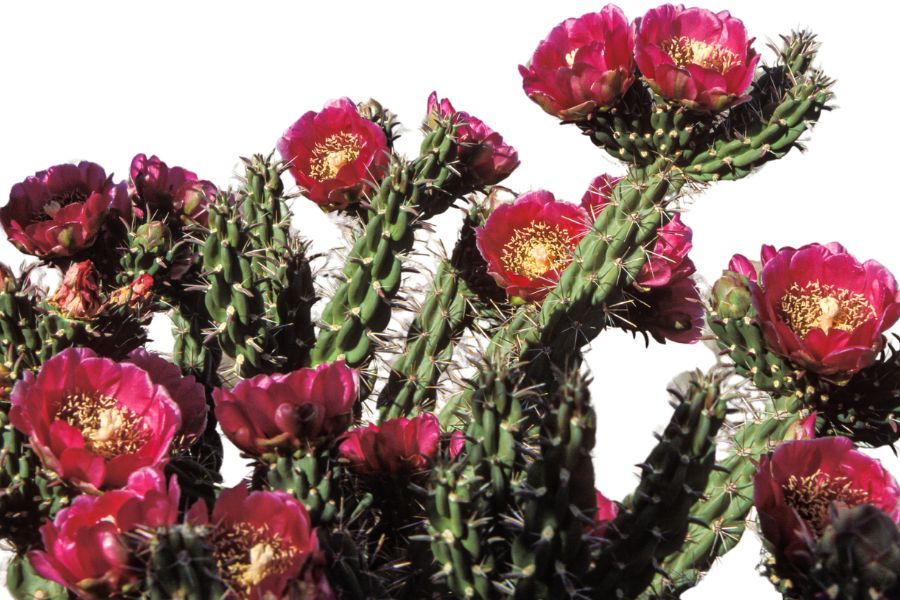New Mexico has a long list of native and naturalized plants that are not only edible, but easy to miss if you don’t know what you’re looking at.
You might walk right past the narrow stalks of fireweed or the low-growing leaves of purslane without realizing both have been eaten for generations. Even the bright yellow sunflower, so common across the landscape, offers more than one edible part.
There’s no single look or shape to expect. Some of these plants grow close to the ground while others stretch tall or climb, but all of them offer something useful if you can identify them. A few, like wild bergamot, even double as flavoring herbs.
It doesn’t take much to start seeing how many of these edible plants are all around you in New Mexico. Once you can recognize a handful of them, you may be surprised at how many others stand out. Knowing what to look for can mean going home with a basket full of very different edible finds.
What We Cover In This Article:
- The Edible Plants Found in the State
- Toxic Plants That Look Like Edible Plants
- How to Get the Best Results Foraging
- Where to Find Forageables in the State
- Peak Foraging Seasons
- The extensive local experience and understanding of our team
- Input from multiple local foragers and foraging groups
- The accessibility of the various locations
- Safety and potential hazards when collecting
- Private and public locations
- A desire to include locations for both experienced foragers and those who are just starting out
Using these weights we think we’ve put together the best list out there for just about any forager to be successful!
A Quick Reminder
Before we get into the specifics about where and how to find these plants and mushrooms, we want to be clear that before ingesting any wild plant or mushroom, it should be identified with 100% certainty as edible by someone qualified and experienced in mushroom and plant identification, such as a professional mycologist or an expert forager. Misidentification can lead to serious illness or death.
All plants and mushrooms have the potential to cause severe adverse reactions in certain individuals, even death. If you are consuming wild foragables, it is crucial to cook them thoroughly and properly and only eat a small portion to test for personal tolerance. Some people may have allergies or sensitivities to specific mushrooms and plants, even if they are considered safe for others.
The information provided in this article is for general informational and educational purposes only. Foraging involves inherent risks.
The Edible Plants Found in the State
Wild plants found across the state can add fresh, seasonal ingredients to your meals:
Amaranth (Amaranthus spp.)
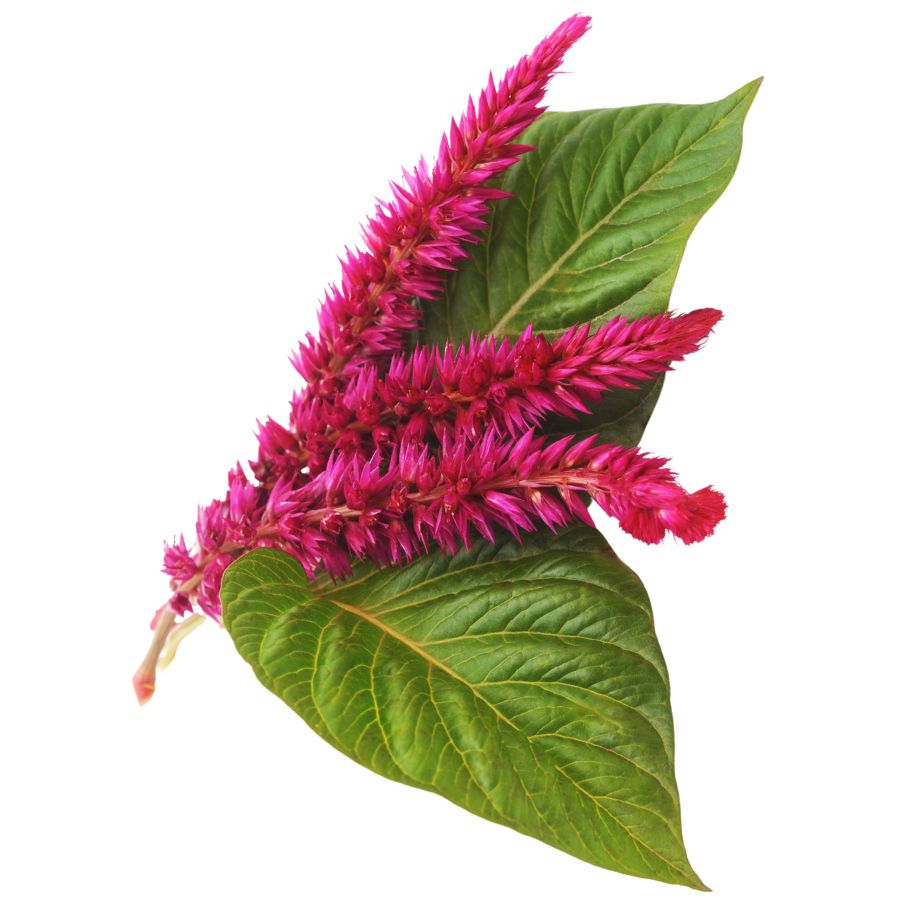
Amaranth has broad, often reddish-tinged leaves and dense flower spikes that range from green to deep purple. You can eat both the leaves and the seeds, with the leaves tasting slightly earthy and the seeds having a nutty flavor when cooked.
Boil or sauté the young leaves like spinach, or use the seeds as a grain substitute in porridge or flatbreads. Avoid pigweed lookalikes—while related, some varieties grow in contaminated soils or accumulate nitrates, making them a risky choice.
The seeds of amaranth are tiny, round, and can be white, golden, or dark brown, depending on the variety. Cooked seeds have a slightly chewy texture and pop a bit when heated, similar to quinoa.
Amaranth leaves are more tender when young and can be eaten raw, but mature leaves need cooking to soften their fibrous texture. There’s nothing toxic in the plant itself, but overconsumption of raw leaves can irritate due to oxalates.
Wild Bergamot (Monarda fistulosa)
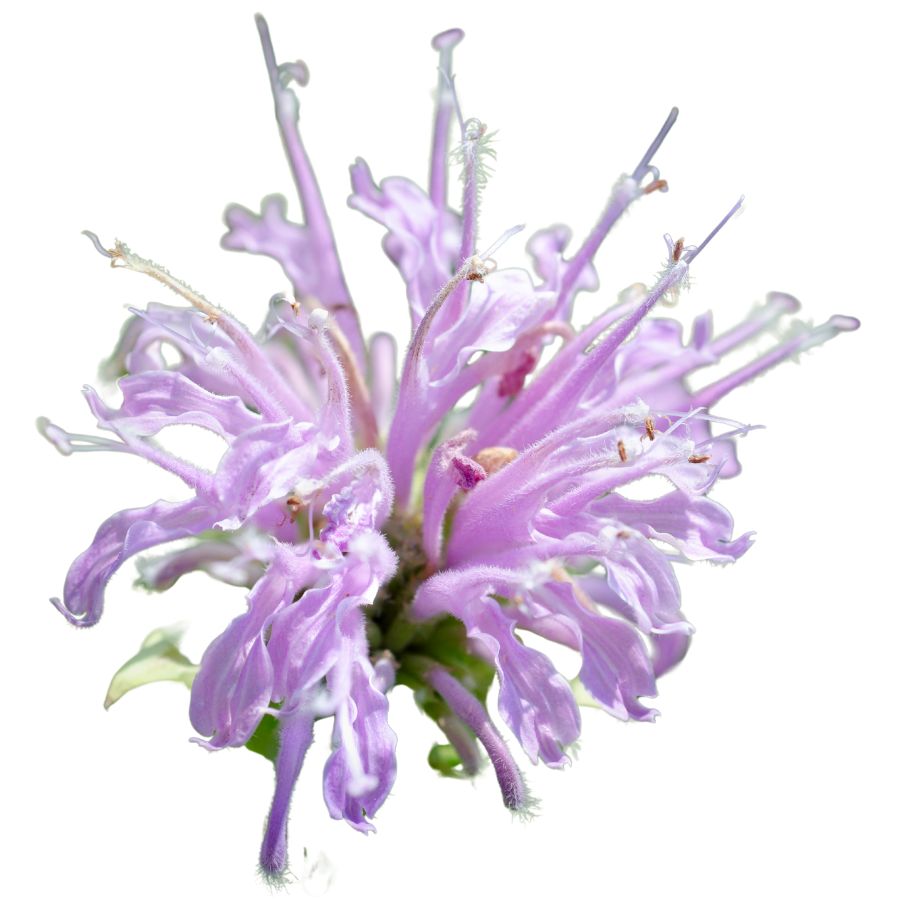
Wild bergamot has clusters of lavender-colored flowers and opposite leaves that smell like thyme when crushed. Its flavor leans herbal and minty, with a little bitterness that works well in marinades.
The flower heads are shaggy and irregular, and the plant’s square stem helps tell it apart from lookalikes like spotted horsemint.
In recipes, it’s most often dried and steeped or blended into herb mixes.
Both leaves and petals can be eaten, though most people avoid the stems. Don’t eat it in large amounts raw—it’s strong and can be overpowering.
It’s related to mint, and that shows in how fast the flavor develops when heat is applied. You’ll get the most aroma if you bruise the leaves before using them.
Cattail (Typha latifolia)
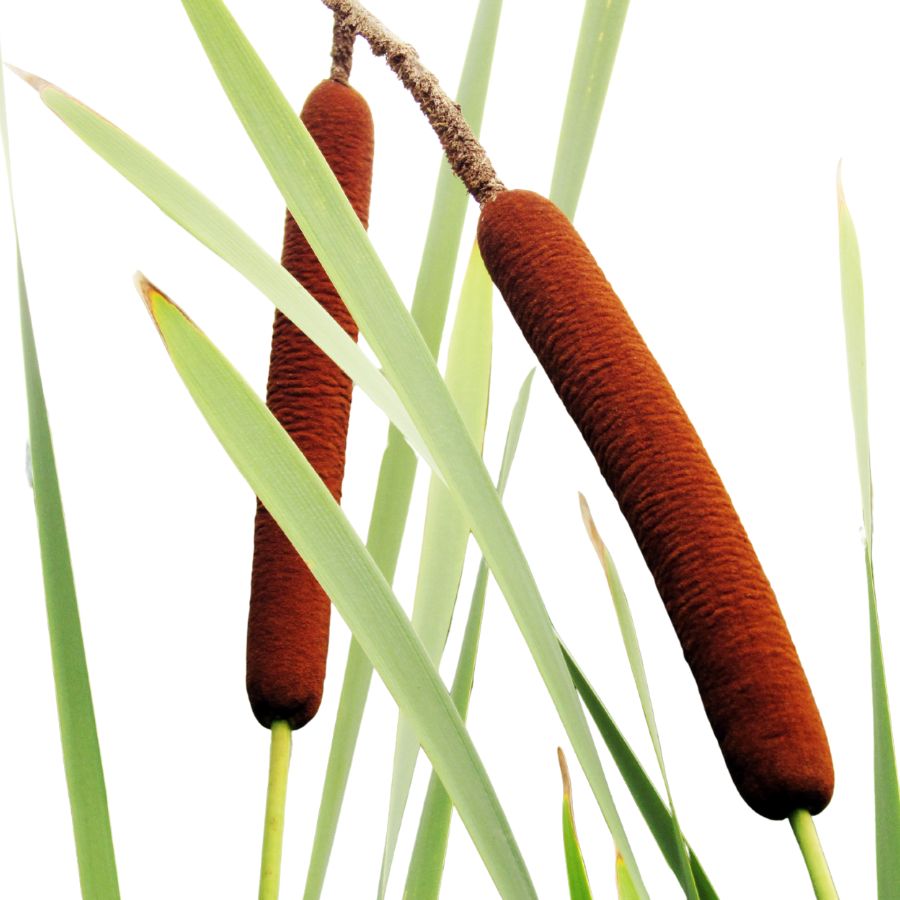
Cattails, often called bulrushes or corn dog grass, are easy to spot with their tall green stalks and brown, sausage-shaped flower heads. They grow thickly along the edges of ponds, lakes, and marshes, forming dense stands that are hard to miss.
Almost every part of the cattail is edible, including the young shoots, flower heads, and starchy rhizomes. You can eat the tender shoots raw, boil the flower heads like corn on the cob, or grind the rhizomes into flour for baking.
Besides food, cattails have long been used for making mats, baskets, and even insulation by weaving the dried leaves and using the fluffy seeds. Their combination of usefulness and abundance has made them an important survival plant for many cultures.
One thing you need to watch for is young cattail shoots being confused with similar-looking plants like iris, which are toxic. A real cattail shoot will have a mild cucumber-like smell when you snap it open, while iris plants smell bitter or unpleasant.
Cholla Cactus (Cylindropuntia spp.)
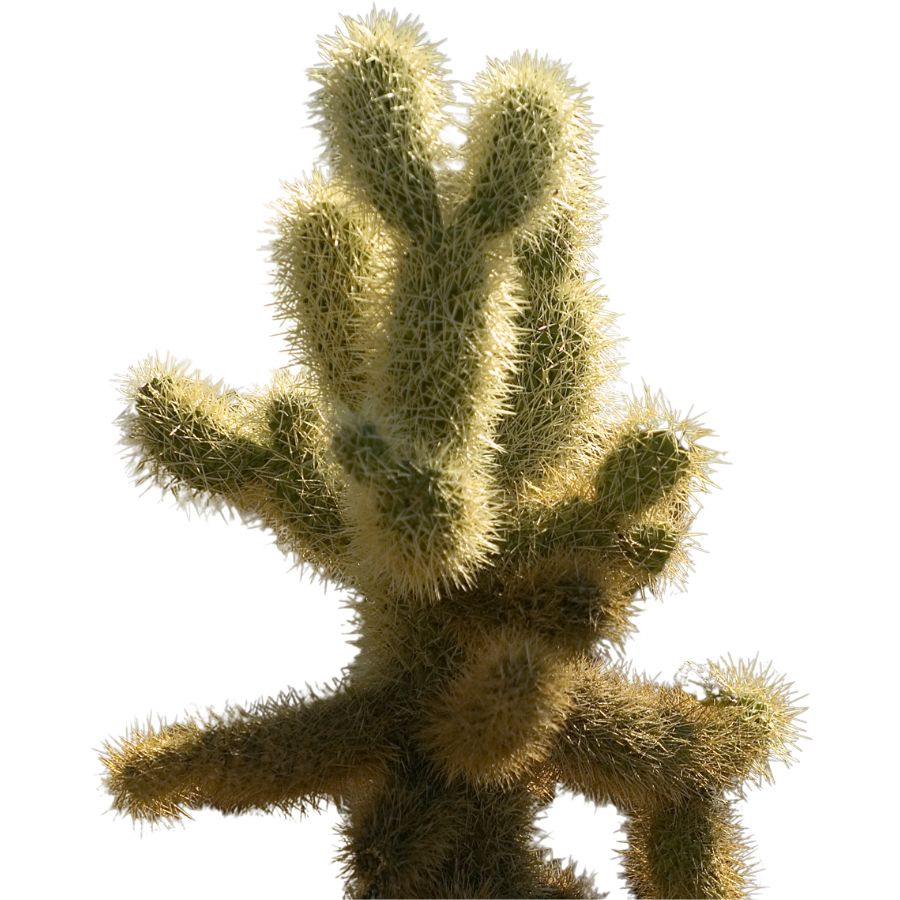
If you’re dealing with a cactus that has segmented, barbed joints that cling to you like Velcro, you’ve probably found cholla. The young joints and ripe fruit are the most commonly eaten, though you’ll need thick gloves and careful handling to get to them.
The fruit has a sweet flavor with a mild strawberry taste, while the raw joints—especially from jumping cholla—have a texture and flavor similar to kiwi. Most people cook the joints to reduce the chance of stomach irritation.
Spines must be thoroughly removed from both parts before eating, as even the smallest ones can cause injury. Use tongs or fire to help dislodge the glochids, which are tiny, hair-like barbs hidden among the bigger spines.
Some varieties of cholla may resemble non-edible or less desirable cacti, but their segmented cylindrical stems set them apart. Always avoid woody or older joints, as they’re too tough to chew and not used for food.
Dandelion (Taraxacum officinale)
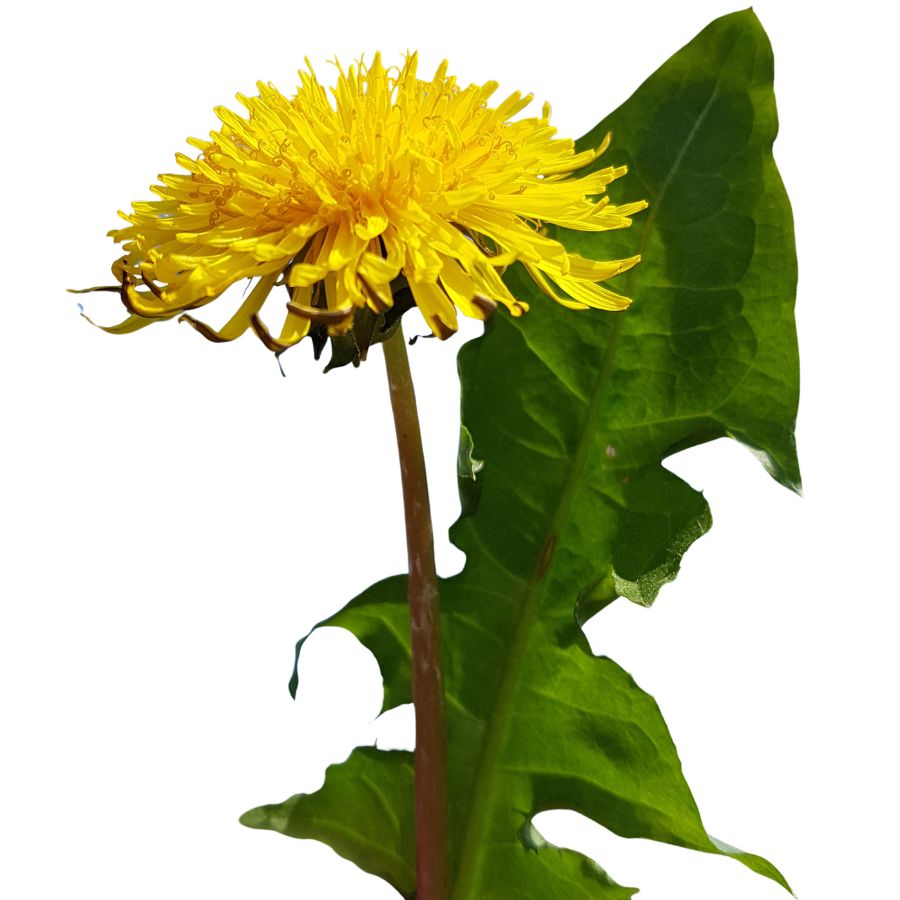
Bright yellow flowers and jagged, deeply toothed leaves make dandelions easy to spot in open fields, lawns, and roadsides. You might also hear them called lion’s tooth, blowball, or puffball once the flowers turn into round, white seed heads.
Every part of the dandelion is edible, but you will want to avoid harvesting from places treated with pesticides or roadside areas with heavy car traffic. Besides being a food source, dandelions have been used traditionally for simple herbal remedies and natural dye projects.
Young dandelion leaves have a slightly bitter, peppery flavor that works well in salads or sautés, and the flowers can be fried into fritters or brewed into tea. Some people even roast the roots to make a coffee substitute with a rich, earthy taste.
One thing to watch out for is cat’s ear, a common lookalike with hairy leaves and branching flower stems instead of a single, hollow one. To make sure you have a true dandelion, check for a smooth, hairless stem that oozes a milky sap when broken.
Curly Dock (Rumex crispus)
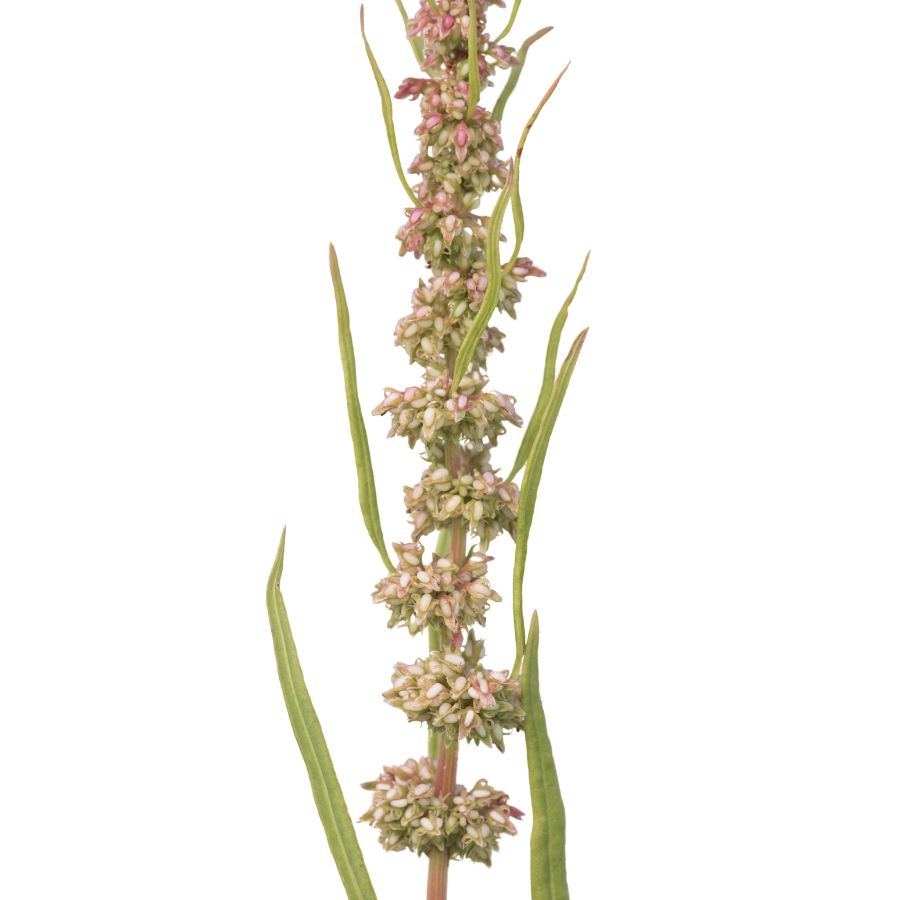
Curly dock, sometimes called yellow dock, is easy to spot once you know what to look for. It has long, wavy-edged leaves that form a rosette at the base, with tall stalks that eventually turn rusty brown as seeds mature.
The young leaves are edible and often cooked to mellow out their sharp, lemony taste, which can be too strong when eaten raw. You can also dry and powder the seeds to use as a flour supplement, although they are tiny and take some effort to prepare.
Curly dock has some lookalikes, like other types of dock and sorrel, but its heavily crinkled leaf edges and thick taproot help it stand out. Be careful not to confuse it with plants like wild rhubarb, which can have toxic parts if misidentified.
Besides being edible, curly dock has a history of being used in homemade remedies for skin irritation. The roots are not eaten raw because they are tough and contain compounds that can upset your stomach if you are not careful.
Colorado Pinyon (Pinus edulis)

Colorado pinyon gives you a dense, nutritious nut hidden inside sticky, pitch-covered cones. When shelled and roasted, the nut has a mild sweetness and a soft, oily bite that makes it ideal for both snacking and cooking.
You might confuse it with other high-desert pines, but remember: Colorado pinyon has two short, curved needles per bundle. Trees with three or more needles are from different species and often produce bitter or useless seeds.
The edible part is only the inner seed, not the shell or cone, which are too tough and sappy to use. Some folks grind the roasted seeds into a spread or mix them with cornmeal for a protein-rich dough.
While safe to eat in moderate amounts, eating large volumes raw can cause digestive issues because of the resin content. And if you collect cones early, be ready for sticky fingers—the pitch is no joke.
Indian Ricegrass (Achnatherum hymenoides)
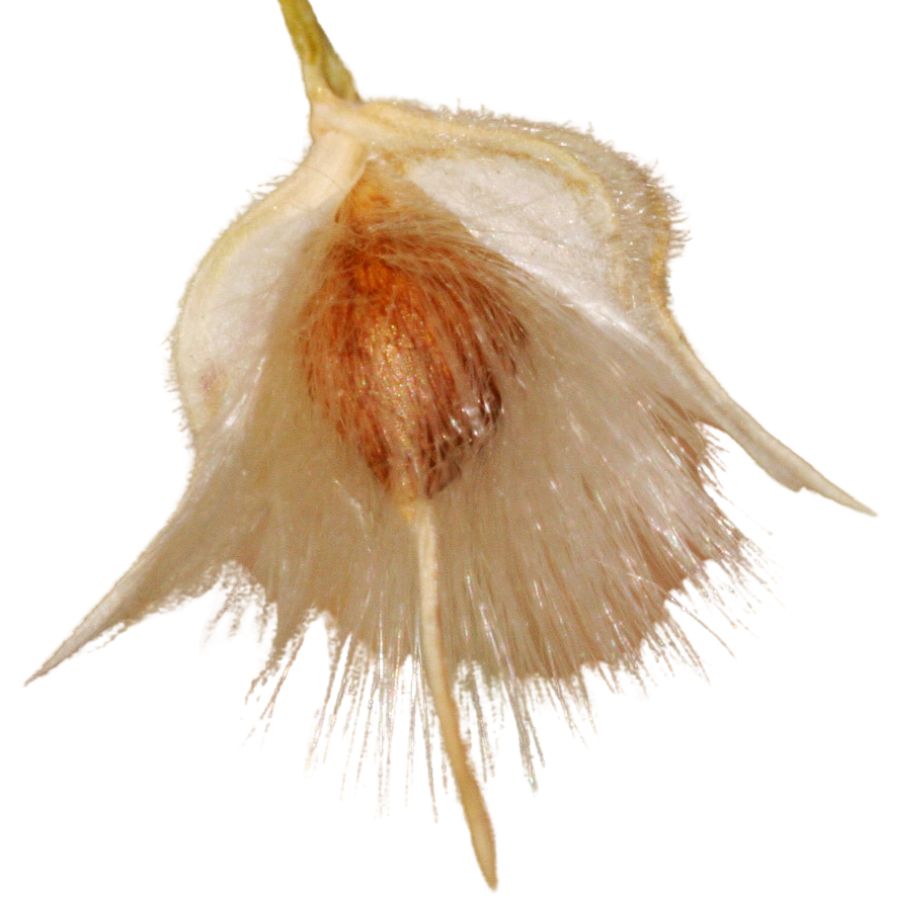
Indian ricegrass is a bunchgrass with fine, narrow leaves and tall, wiry stems topped by open, airy seed heads. The seeds are the edible part, and they’re small, dark, and slightly shiny when mature.
You can grind the seeds into a gluten-free flour with a nutty flavor and soft, slightly chewy texture when cooked. It’s often used in flatbreads, porridge, or just roasted and eaten as a snack.
Its seeds resemble those of needle-and-thread grass, but the latter has long, twisting awns that make it inedible and potentially irritating if ingested. Indian ricegrass lacks those sharp, barbed extensions.
There’s nothing edible about the leaves or stems, and the plant is mostly harvested for its seeds. It was once a staple grain for many Indigenous communities and is now gaining renewed attention for its nutritional value.
Lamb’s Quarters (Chenopodium album)
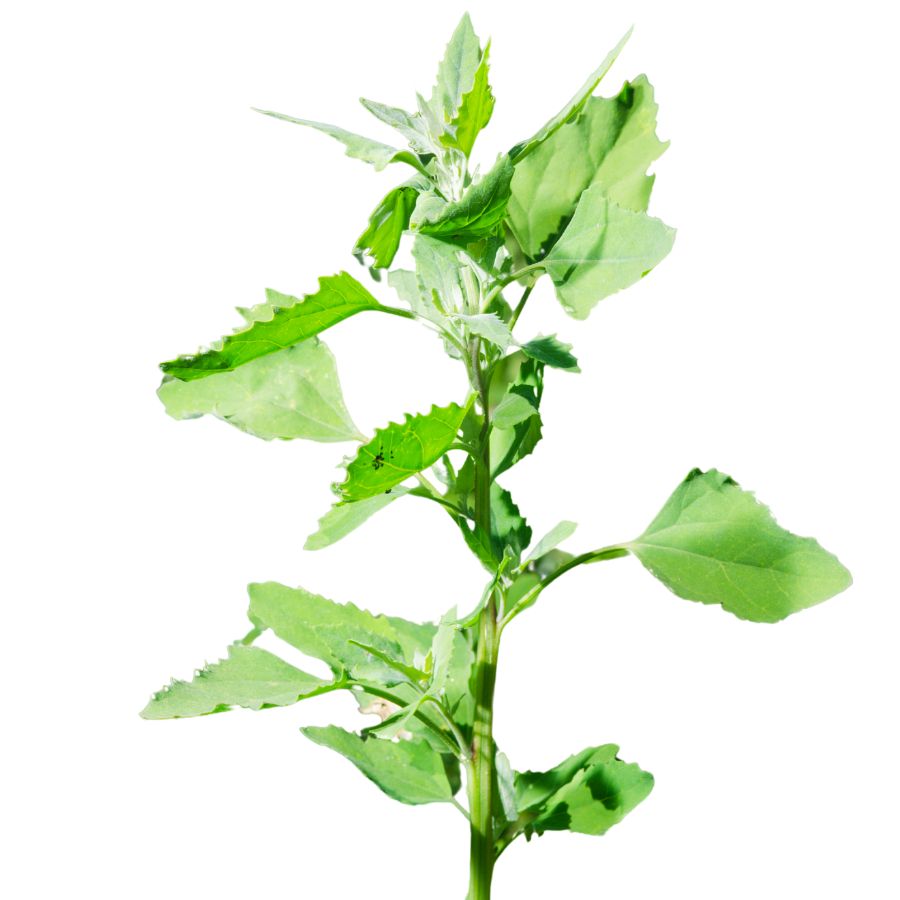
Lamb’s quarters, also called wild spinach and pigweed, has soft green leaves that often look dusted with a white, powdery coating. The leaves are shaped a little like goose feet, with slightly jagged edges and a smooth underside that feels almost velvety when you touch it.
A few plants can be confused with lamb’s quarters, like some types of nightshade, but true lamb’s quarters never have berries and its leaves are usually coated in that distinctive white bloom. Always check that the stems are grooved and not round and smooth like the poisonous lookalikes.
When you taste lamb’s quarters, you will notice it has a mild, slightly nutty flavor that gets richer when cooked. The young leaves, tender stems, and even the seeds are all edible, but you should avoid eating the older stems because they become tough and stringy.
People often sauté lamb’s quarters like spinach, blend it into smoothies, or dry the leaves for later use in soups and stews. It is also rich in oxalates, so you will want to cook it before eating large amounts to avoid any problems.
Narrowleaf Yucca (Yucca angustissima)
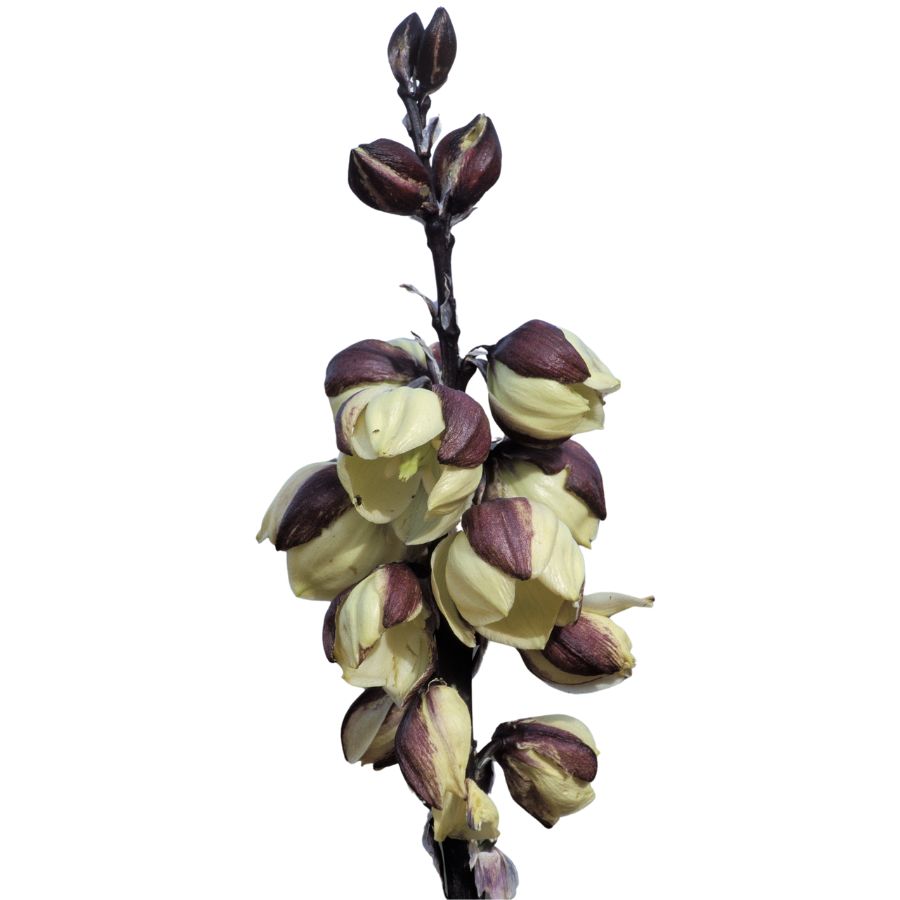
Narrowleaf yucca has long, slender leaves with curling threads and a flower stalk that can reach several feet tall. The flowers and central stalk are edible, but you’ll need to prepare them correctly to get good results.
Its fibrous leaves are not edible and should be avoided, even though they look similar in color and structure to parts of the plant that are. Compared to other yucca species, narrowleaf has thinner leaves and a more upright, spindly form.
The flower petals have a slightly soapy taste when raw, but cooking removes the bitterness and softens the texture. Roasting the stalk enhances its sweetness and gives it a tender, root-like consistency.
Don’t eat the root or try to chew the older leaves. They aren’t digestible and have no culinary use. Focus on the tender parts, and you’ll find the plant can be a surprisingly versatile wild food.
Plantain (Plantago major)
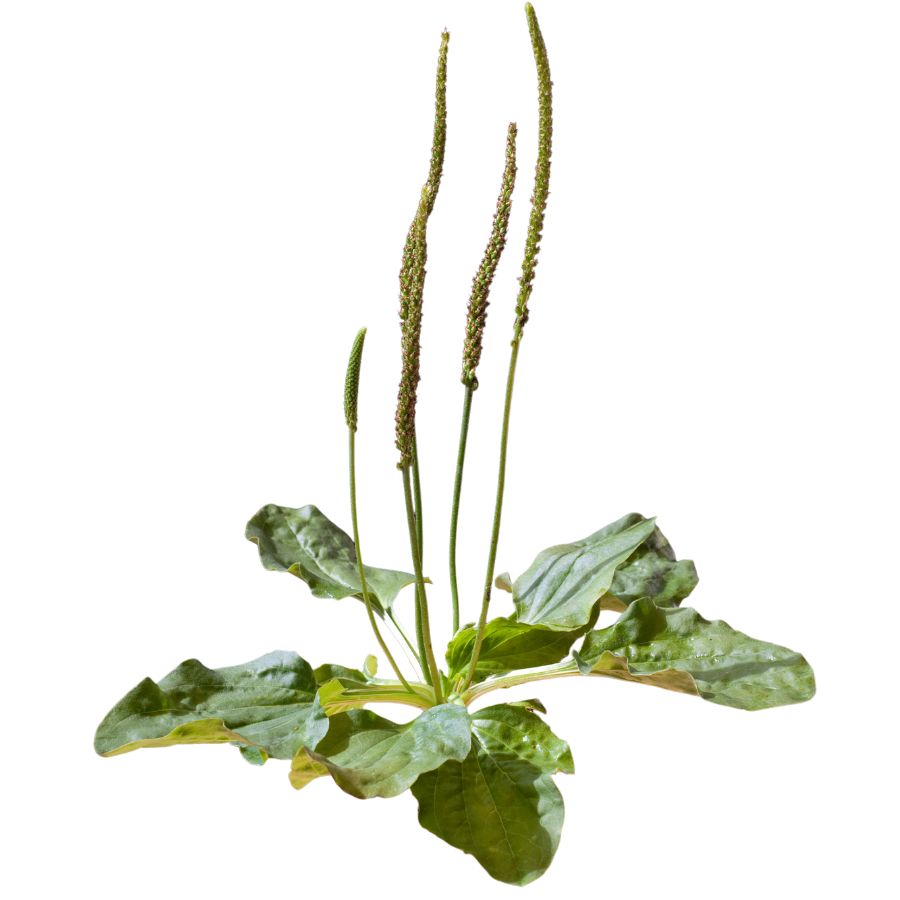
Plantain, also called common plantain or narrowleaf plantain depending on the type, is a low-growing plant with broad or lance-shaped leaves and tall, slender flower spikes. The leaves grow in a rosette close to the ground, and the thick veins running through them are one of the easiest ways to tell it apart from other plants.
You can mainly eat the young leaves and the seeds of the plants. Older leaves can become tough and stringy, so it is best to pick the smaller, tender ones when you want to eat them.
Plantain leaves have a slightly bitter, earthy taste and a chewy texture, especially when eaten raw. Many people like to add them to salads, soups, or stews, or lightly steam them to soften the flavor.
Always make sure you have a true plantain before eating because some similar-looking yard plants are not palatable and can upset your stomach. Look for the strong parallel veins and the tough, fibrous stems to help confirm your find.
Tulip Prickly Pear Cactus (Opuntia phaeacantha)
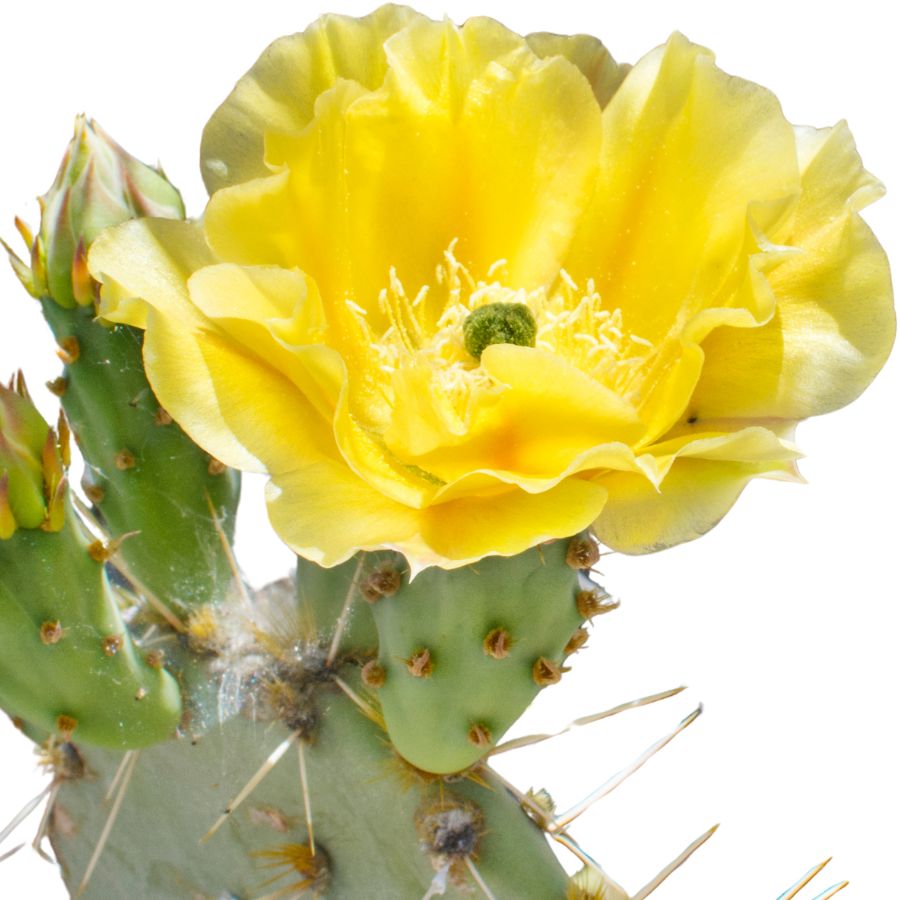
Tulip prickly pear cactus pads are green, oval, and covered with clusters of long reddish spines, and its large yellow-to-orange flowers help distinguish it from less palatable relatives. Both the pads and the fruits are edible, but you must clean them thoroughly to remove all spines and glochids.
When prepared properly, the pads have a crisp texture with a tart, lemony taste, while the fruit is sweet and juicy with a flavor similar to melon. You can grill the pads with oil and spices or boil them to add to stews and tacos, while the fruit is often peeled and eaten raw or used in jams.
Other prickly pears might look similar but have woody or overly mucilaginous pads that don’t cook down well or taste bitter. The tulip variety has smoother flesh and fewer interior fibers when harvested at the right size.
Never eat any part of the cactus raw without removing the glochids, which are tiny, hair-like spines that can embed painfully in your skin and mouth. The interior flesh is edible, but the peel and spines should be discarded completely.
Purslane (Portulaca oleracea)
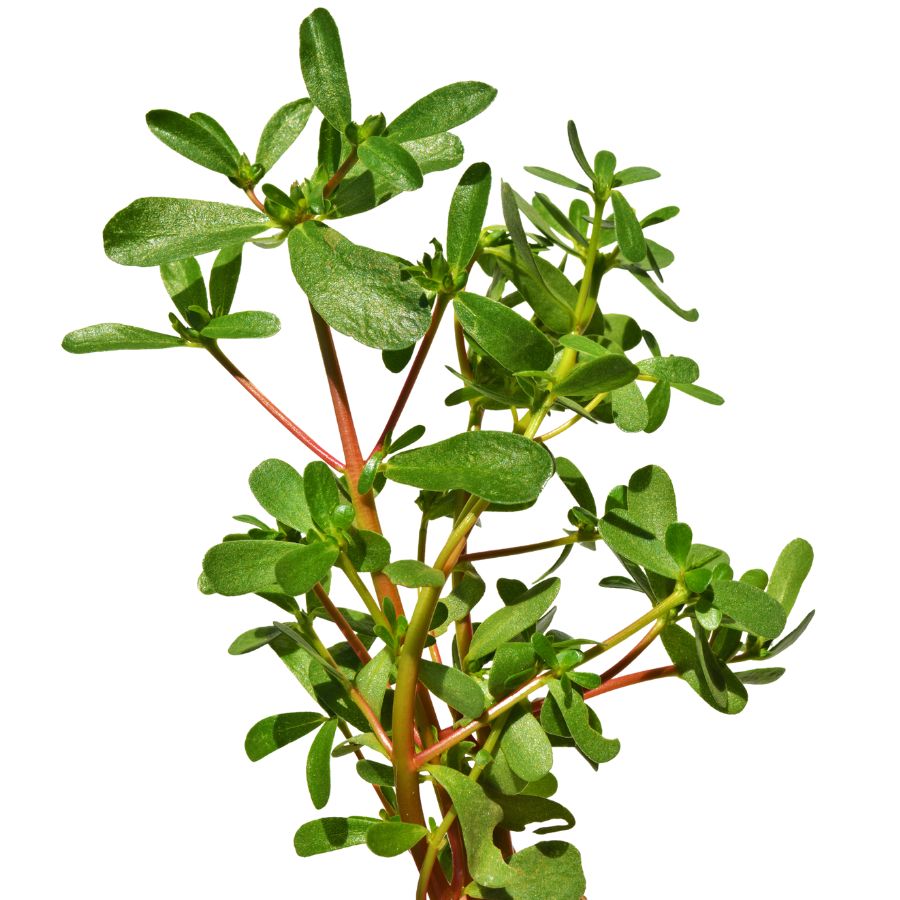
Purslane is a hardy, low-growing plant that’s also sometimes known as little hogweed or verdolaga. It has smooth, reddish stems and thick, paddle-shaped leaves that feel a bit waxy when you touch them.
The stems, leaves, and tiny yellow flowers are all edible, while the roots are not typically eaten. Purslane has a crisp texture with a slightly tart, lemony flavor that works well raw or cooked.
Some plants that look similar include spurge, which has a milky sap and is not edible, so it is important to check for purslane’s smooth, succulent stems and lack of sap. Always double-check by gently snapping a stem to make sure no white liquid appears.
You can toss fresh purslane into salads, sauté it lightly like spinach, or pickle it for later use. Its mild tartness and slight crunch make it a refreshing addition to sandwiches, soups, and even stir-fries.
Rocky Mountain Bee Plant (Cleome serrulata)
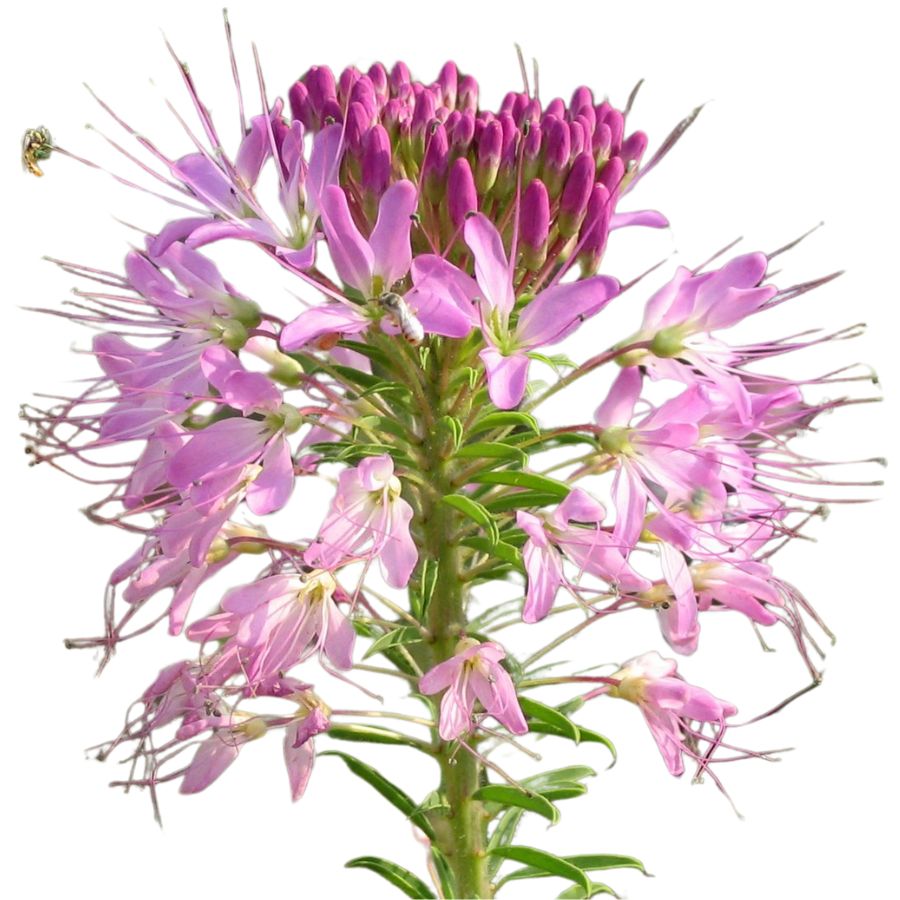
Rocky mountain bee plant has tall, spindly stems topped with brushy flower clusters in pink or purple shades, and its leaves grow in sets of three narrow leaflets. It can be confused with some wild mustard species, but those usually have broader leaves and a much different flower arrangement.
The tender parts of the plant, like young leaves and seedpods, are edible and usually need cooking to reduce bitterness. Steamed or boiled, they take on a dense texture and a flavor somewhere between kale and cooked nettles.
Some people use the seeds to make a coarse flour, though it’s more common to use the cooked greens as a vegetable. Fermenting the greens in tightly sealed jars was a preservation method used in some traditional foodways.
Don’t eat the mature leaves raw—they’re too tough and can irritate your digestion. There aren’t any dangerously toxic lookalikes, but misidentifying it could still lead to unpleasant meals if you grab the wrong plant.
Sunflower (Helianthus annuus)
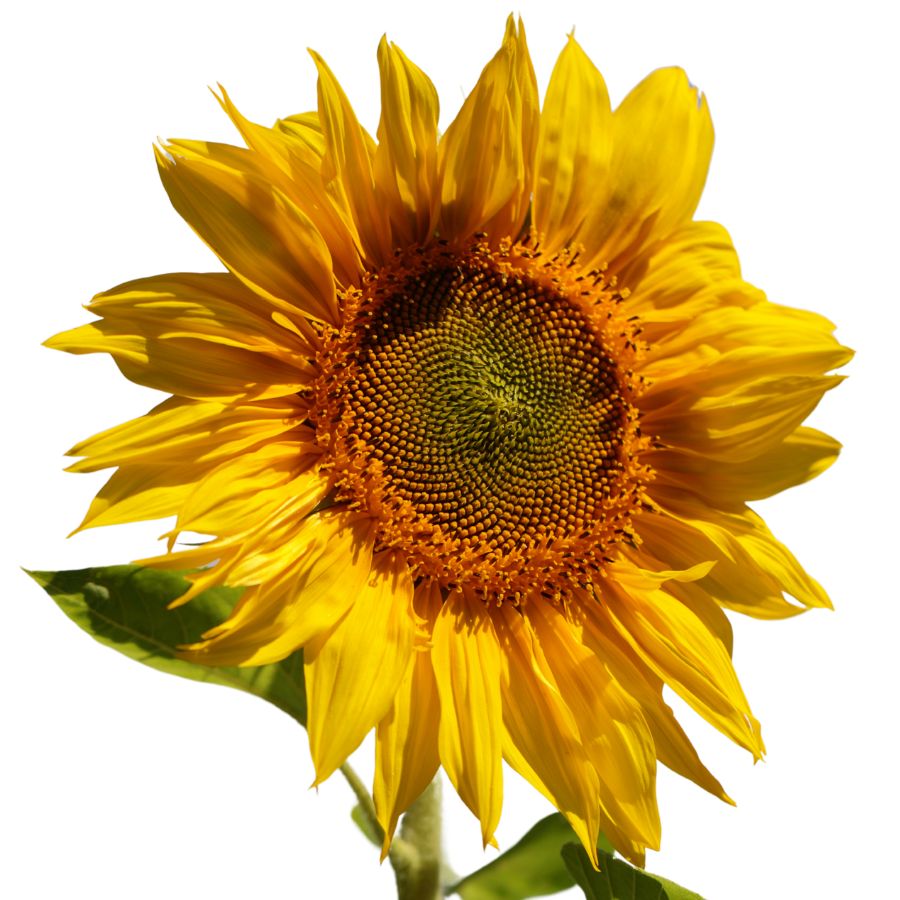
Sunflowers have a thick, rough stem and large, broad leaves with a slightly sandpapery texture. The huge circular flower head is made up of bright yellow petals surrounding a dark center packed with seeds.
The seeds inside the flower head are edible once they mature, and you can eat them raw, roasted, or ground into meal. The young flower buds are also edible and can be steamed or sautéed like an artichoke.
When gathering sunflower seeds, make sure not to confuse the plant with certain types of wild composites that have smaller flowers and thin, spindly stalks. True sunflowers always have a thick, sturdy stem and a flower head that can be as wide as a dinner plate.
Sunflower seeds have a mild, nutty flavor and a tender crunch when fresh. You can also press the seeds for oil or sprout them for a nutritious snack.
Nodding Onion (Allium cernuum)
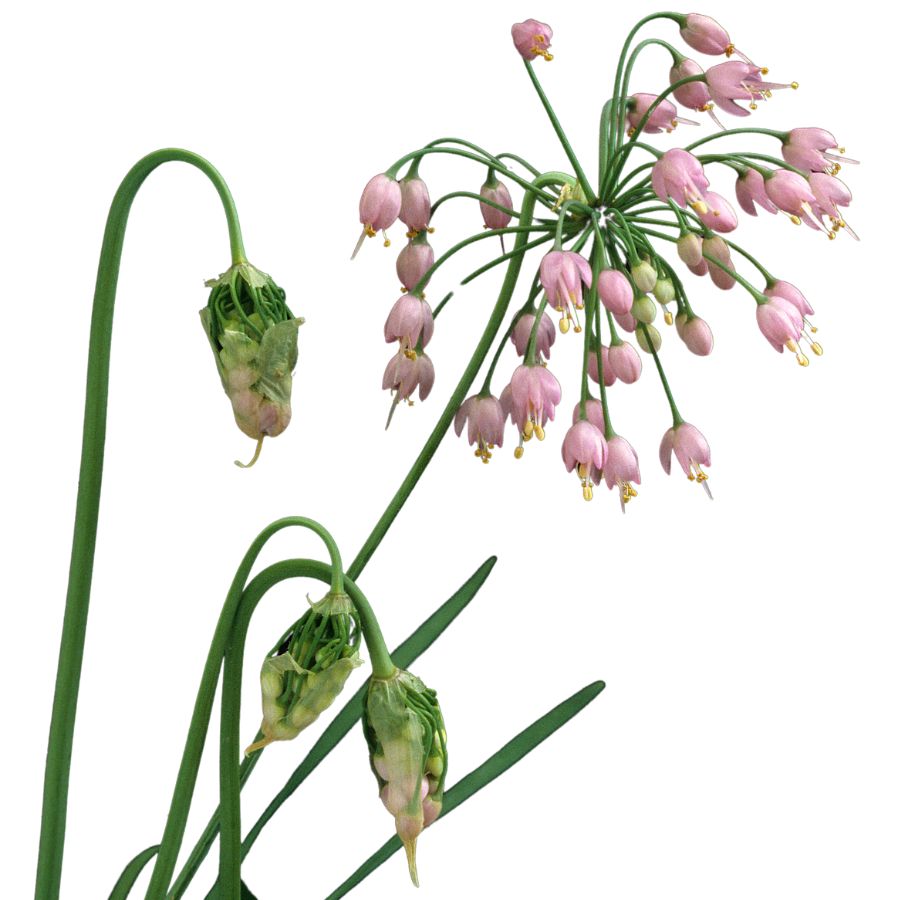
When you come across nodding onions, you’ll notice the drooping flower heads perched on tall, slender stalks. The narrow, grass-like leaves and the pinkish-white blossoms help distinguish them from toxic lookalikes like death camas, which lacks the onion smell when crushed.
You can eat the leaves, bulbs, and flowers, all of which carry a strong onion flavor with a slightly sweet finish. The texture is crisp when raw and softens nicely when sautéed or added to soups.
One popular way to use nodding onions is to mince the greens into spreads or salads, or grill the bulbs whole like scallions. Pickling the flower buds is another method that preserves their tang and adds punch to charcuterie boards.
Avoid harvesting from roadsides or polluted areas, since these plants can absorb contaminants through their roots. While edible, the plant loses flavor quickly after picking, so it’s best to use it fresh whenever possible.
American Licorice (Glycyrrhiza lepidota)
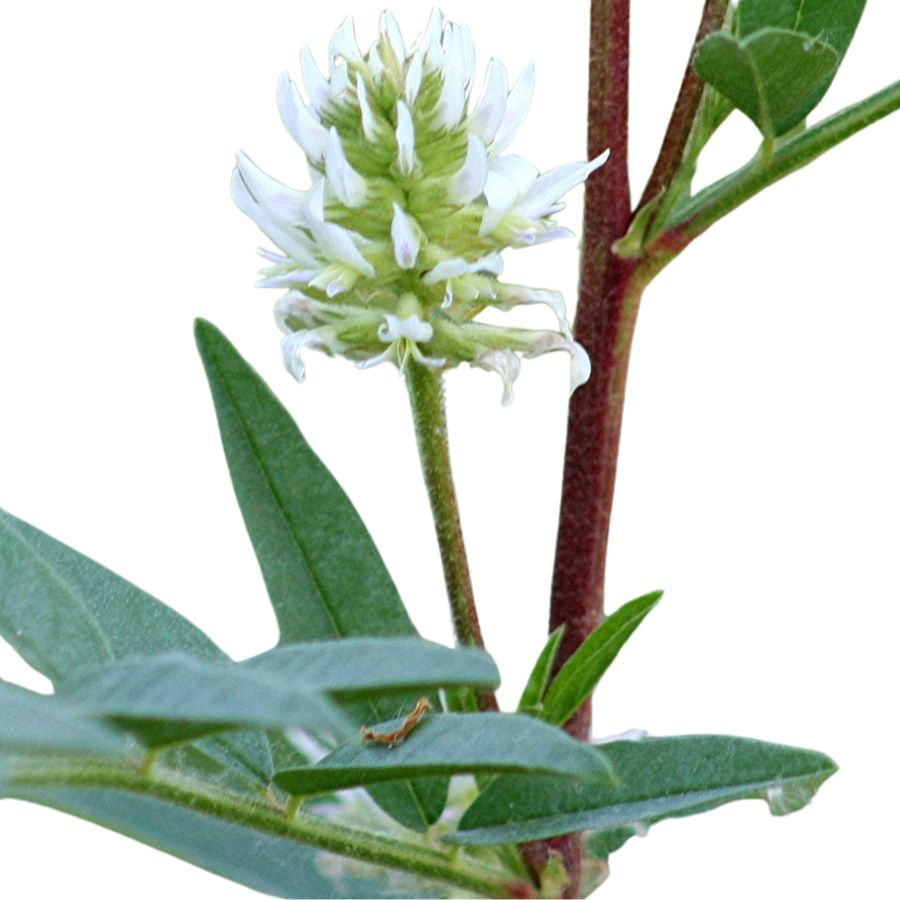
With its bushy stems, pinnate leaves, and fuzzy seed pods, American licorice grows in a way that’s easy to get familiarized with. Break into the root and you’ll notice a distinct sweet aroma and a yellowish core that reveals its value.
People boil the roots to make sweet herbal tea or chew them raw for their intense flavor, which is earthy and complex. Drying and grinding the root for use in syrups or candies is another common method.
Avoid confusing it with similar-looking species like wild vetch or false indigo, both of which lack the licorice scent and may be harmful if eaten. True American licorice also has thicker, more robust roots than those plants.
Only the root should be consumed—the leaves, stems, and seeds aren’t edible. If you’re sensitive to glycyrrhizin, consuming large quantities can mess with your potassium levels and raise your blood pressure.
Fireweed (Chamerion angustifolium)
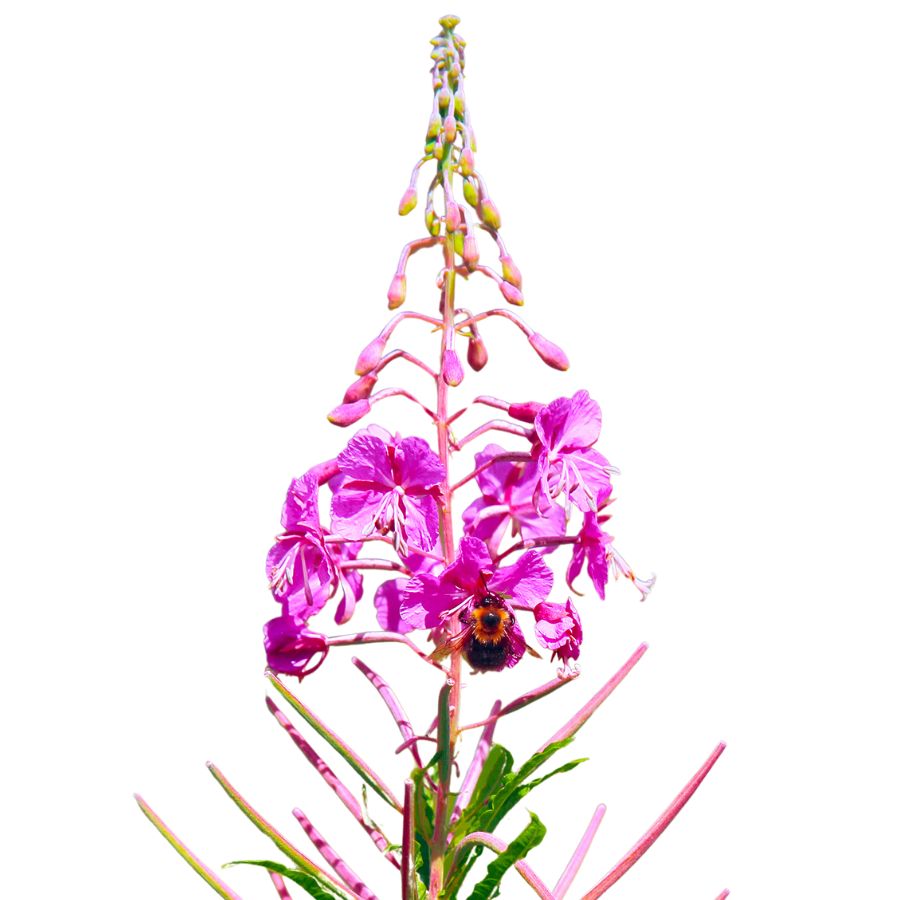
Fireweed produces a spike of bright fuchsia flowers and grows in tall, narrow stands with alternating leaves that taper to a point. The stem often has a reddish hue and a soft fuzz that runs along its surface.
The inner pith of mature stalks is edible and has a faintly sweet flavor, especially when eaten raw. Early shoots can be treated like asparagus—grilled, steamed, or added to stir-fries.
While the plant is generally safe, be cautious not to gather it near roadsides or areas that have been sprayed, as the plant readily colonizes disturbed ground. Fireweed does have a few lookalikes, but most lack the flower’s distinct four-petal shape and central tufted stigma.
The blossoms are sometimes added raw to fruit dishes or frozen into ice cubes for color, and the leaves can be dried and used as a tea substitute. Stick to the younger parts if you want the best texture and flavor.
Golden Currant (Ribes aureum)
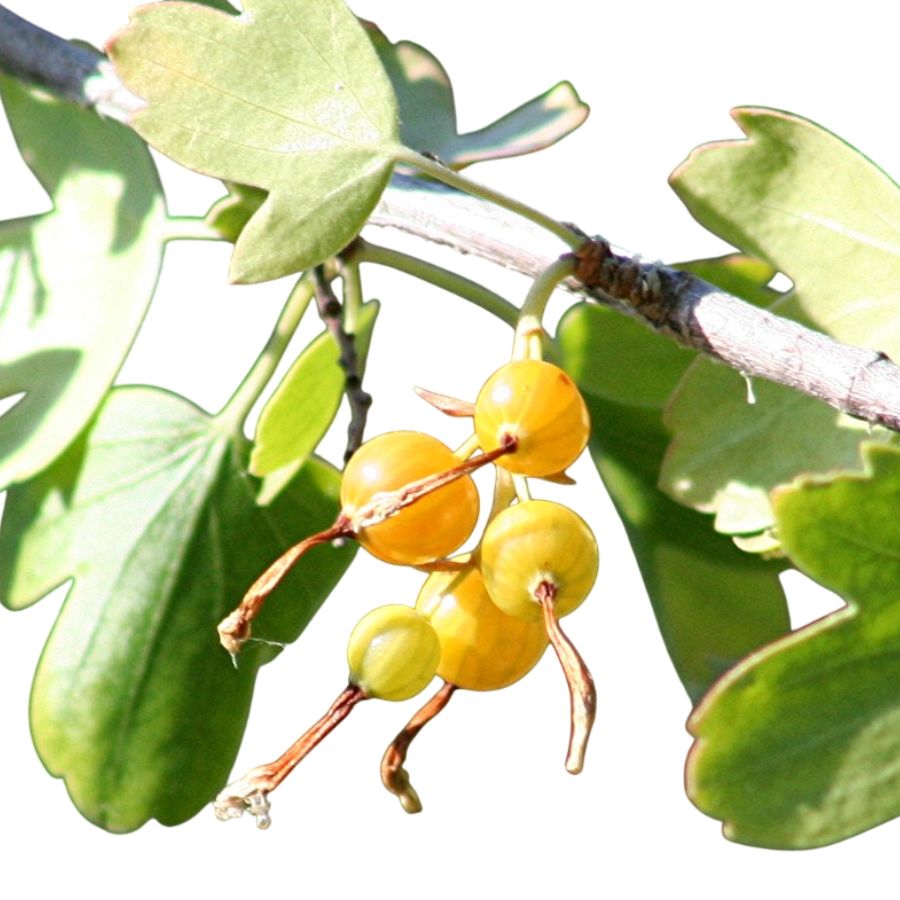
Golden currants produce small, round berries with smooth skin and a color range that includes golden yellow, red, and deep purple. Their flavor is tangy, slightly sweet, and develops a deeper complexity when cooked down.
The berries are edible raw, but you’ll probably want to use them in syrups, sauces, or dried into snacks. Some people dehydrate them like raisins, though they’re smaller and more tart.
Leaves are palmately lobed and lightly scented, which helps set golden currants apart from potentially toxic lookalikes like some ornamental currant hybrids. Those lookalikes often lack the same strong fragrance and have less pronounced lobing on the leaves.
Don’t eat the unripe berries in large amounts, as they can be harsh on the stomach. Fermenting the juice was a traditional method of preservation among various communities, adding a unique use to its culinary profile.
Woods’ Rose (Rosa woodsii)
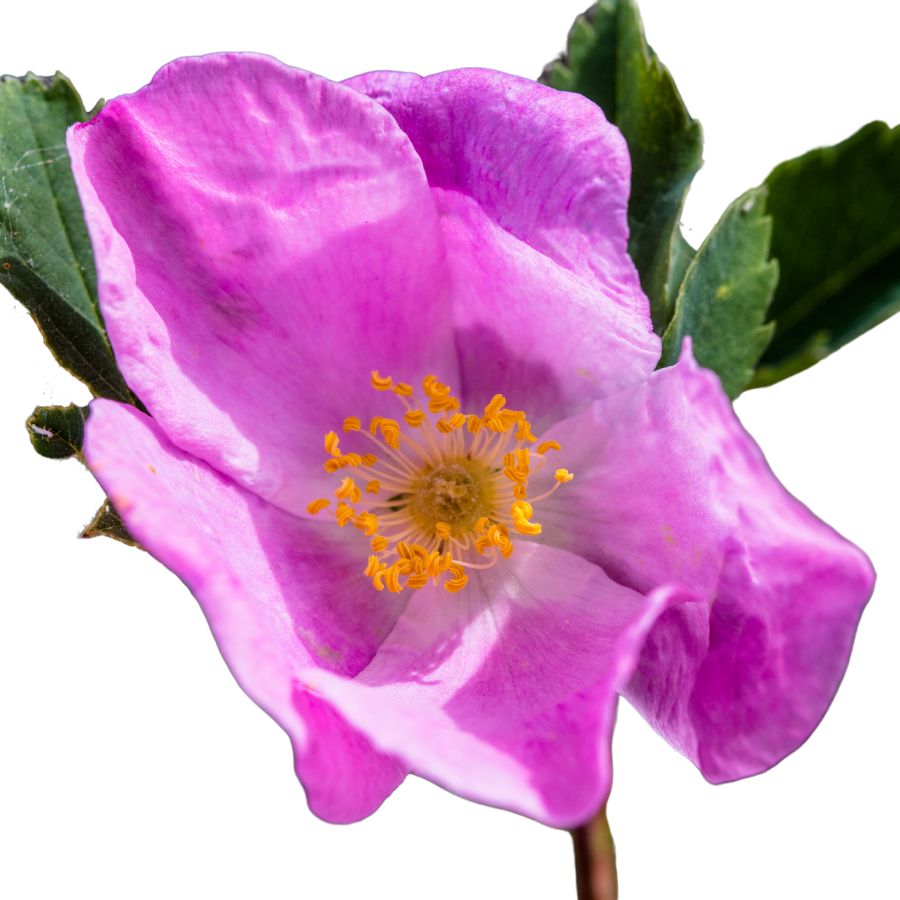
Woods’ rose, also referred to as wild rose or western wild rose, grows as a shrub with pink to deep rose-colored blooms and curved prickles along its stem. Its red-orange hips are round or slightly oval and ripen fully to a firm, leathery texture.
You can eat the hips raw after removing the seeds and tiny hairs, but they’re more palatable when cooked into sauces, used in baked goods, or dried for tea. The flavor is tart, similar to crabapple, and the flesh is dense and chewy when dried.
Rose petals from this plant are also edible and can be eaten fresh or used to flavor vinegars and desserts. Be cautious around rose lookalikes like Japanese rose, which produces similar hips but often has more rigid stems and smoother leaves.
Never ingest the stems or roots—those parts have no food value and can irritate your digestive tract. The hips were used in some traditional food preparations for their nutritional benefits, especially during food-scarce times.
Toxic Plants That Look Like Edible Plants
There are plenty of wild edibles to choose from, but some toxic native plants closely resemble them. Mistaking the wrong one can lead to severe illness or even death, so it’s important to know exactly what you’re picking.
Poison Hemlock (Conium maculatum)
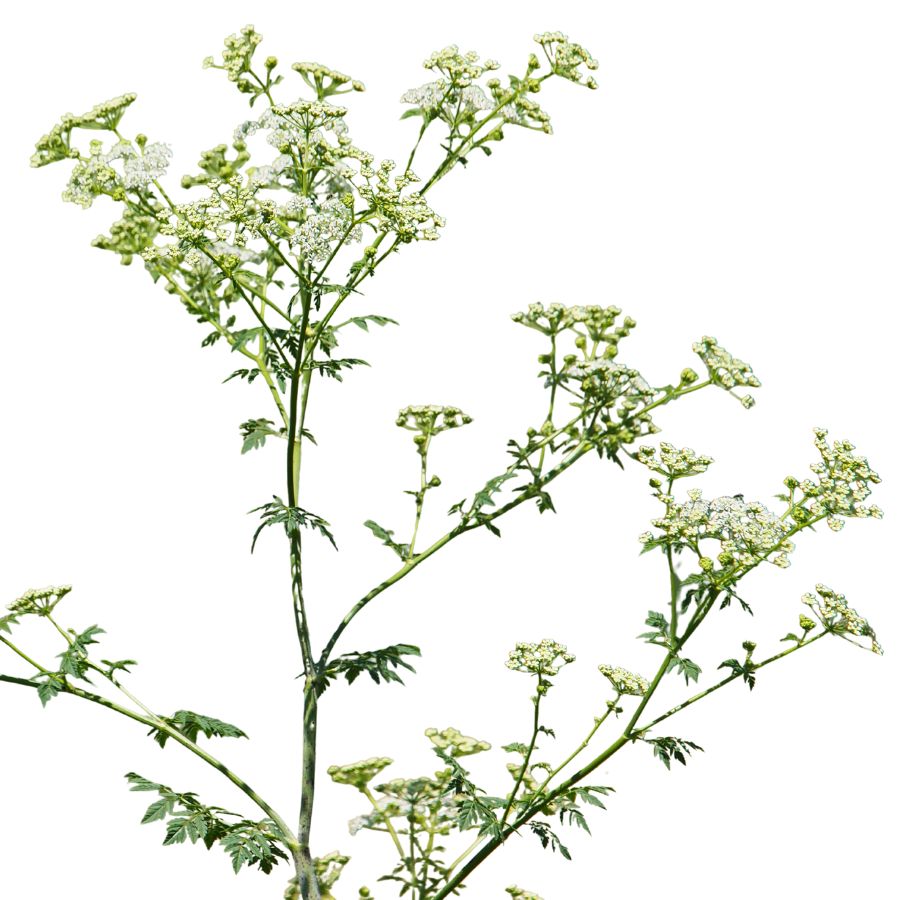
Often mistaken for: Wild carrot (Daucus carota)
Poison hemlock is a tall plant with lacy leaves and umbrella-like clusters of tiny white flowers. It has smooth, hollow stems with purple blotches and grows in sunny places like roadsides, meadows, and stream banks.
Unlike wild carrot, which has hairy stems and a dark central floret, poison hemlock has a musty odor and no flower center spot. It’s extremely toxic; just a small amount can be fatal, and even touching the sap can irritate the skin.
Water Hemlock (Cicuta spp.)
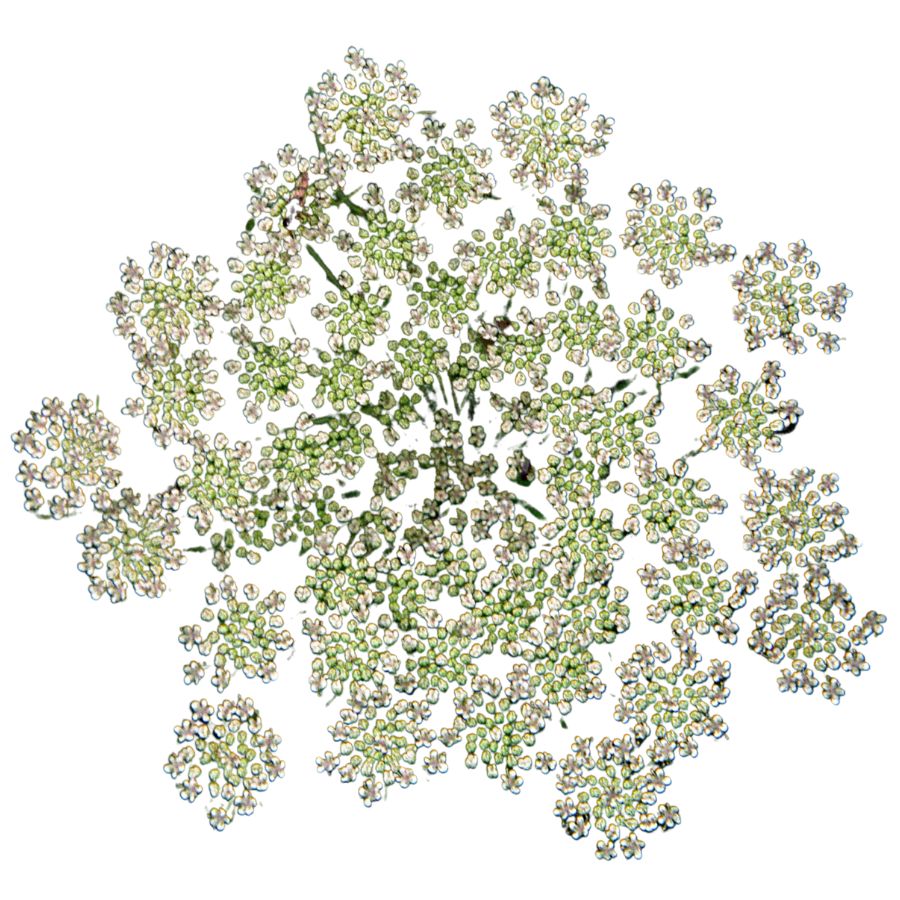
Often mistaken for: Wild parsnip (Pastinaca sativa) or wild celery (Apium spp.)
Water hemlock is a tall, branching plant with umbrella-shaped clusters of small white flowers. It grows in wet places like stream banks, marshes, and ditches, with stems that often show purple streaks or spots.
It can be confused with wild parsnip or wild celery, but its thick, hollow roots have internal chambers and release a yellow, foul-smelling sap when cut. Water hemlock is the most toxic plant in North America, and just a small amount can cause seizures, respiratory failure, and death.
False Hellebore (Veratrum viride)
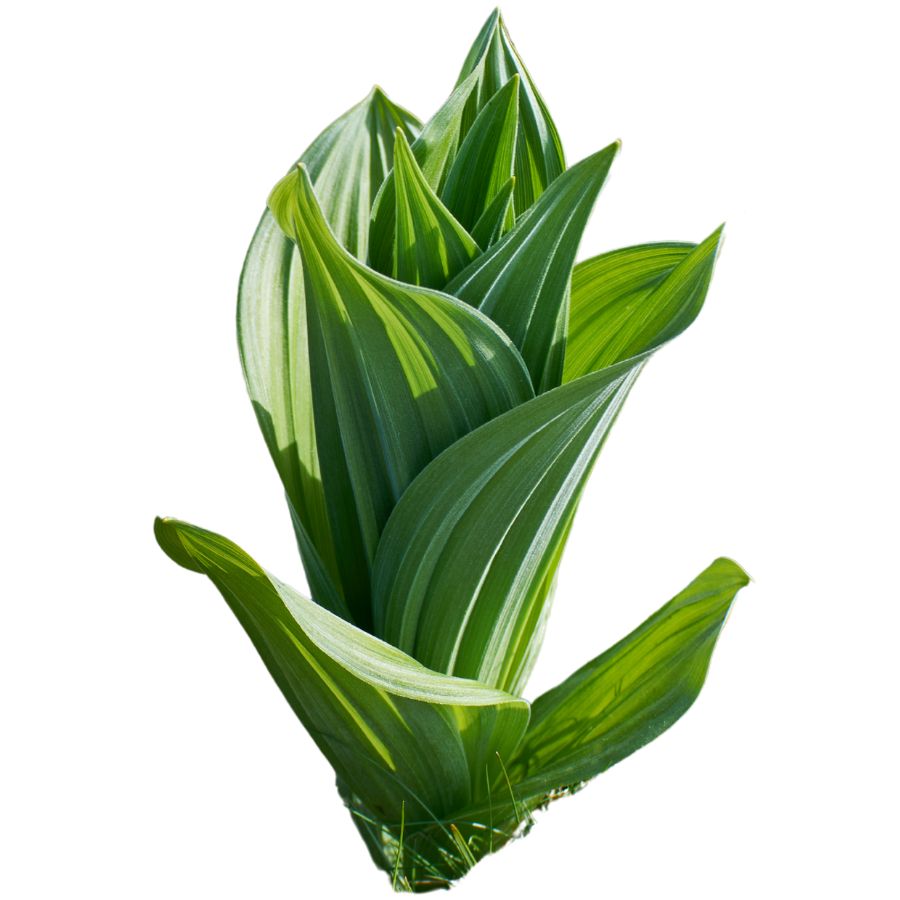
Often mistaken for: Ramps (Allium tricoccum)
False hellebore is a tall plant with broad, pleated green leaves that grow in a spiral from the base, often appearing early in spring. It grows in moist woods, meadows, and along streams.
It’s commonly mistaken for ramps, but ramps have a strong onion or garlic smell, while false hellebore is odorless and later grows a tall flower stalk. The plant is highly toxic, and eating any part can cause nausea, a slowed heart rate, and even death due to its alkaloids that affect the nervous and cardiovascular systems.
Death Camas (Zigadenus spp.)
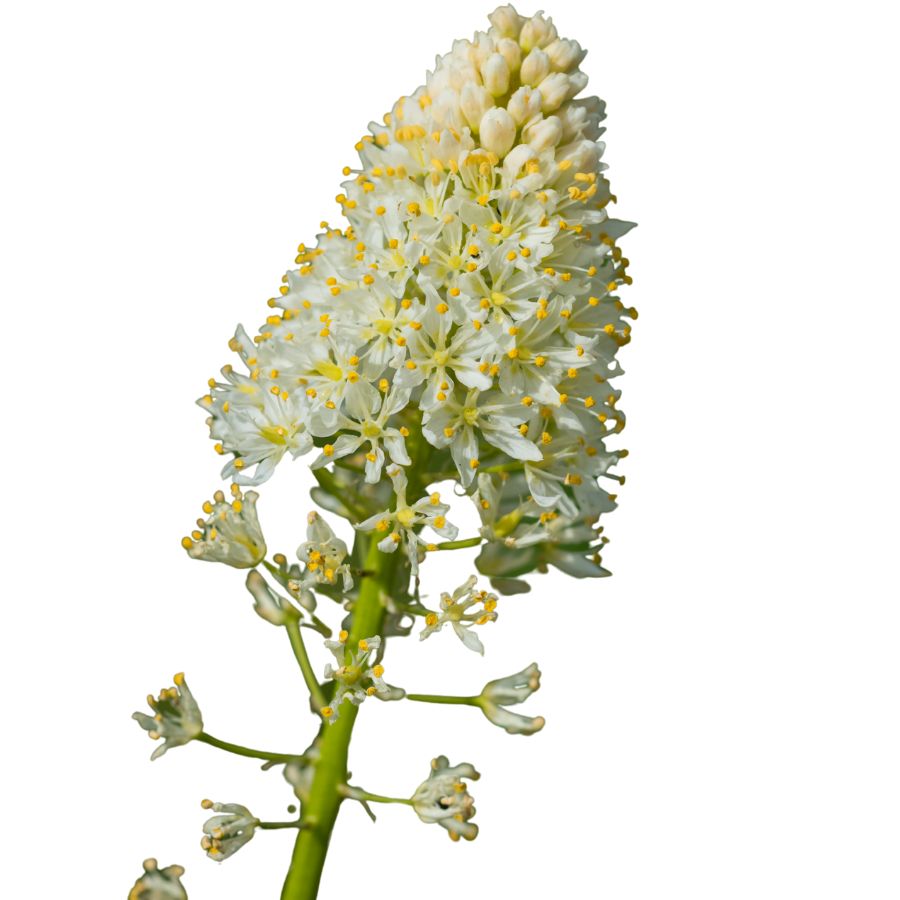
Often mistaken for: Wild onion or wild garlic (Allium spp.)
Death camas is a slender, grass-like plant that grows from underground bulbs and is found in open woods, meadows, and grassy hillsides. It has small, cream-colored flowers in loose clusters atop a tall stalk.
It’s often confused with wild onion or wild garlic due to their similar narrow leaves and habitats, but only Allium plants have a strong onion or garlic scent, while death camas has none. The plant is extremely poisonous, especially the bulbs, and even a small amount can cause nausea, vomiting, a slowed heartbeat, and potentially fatal respiratory failure.
Buckthorn Berries (Rhamnus spp.)
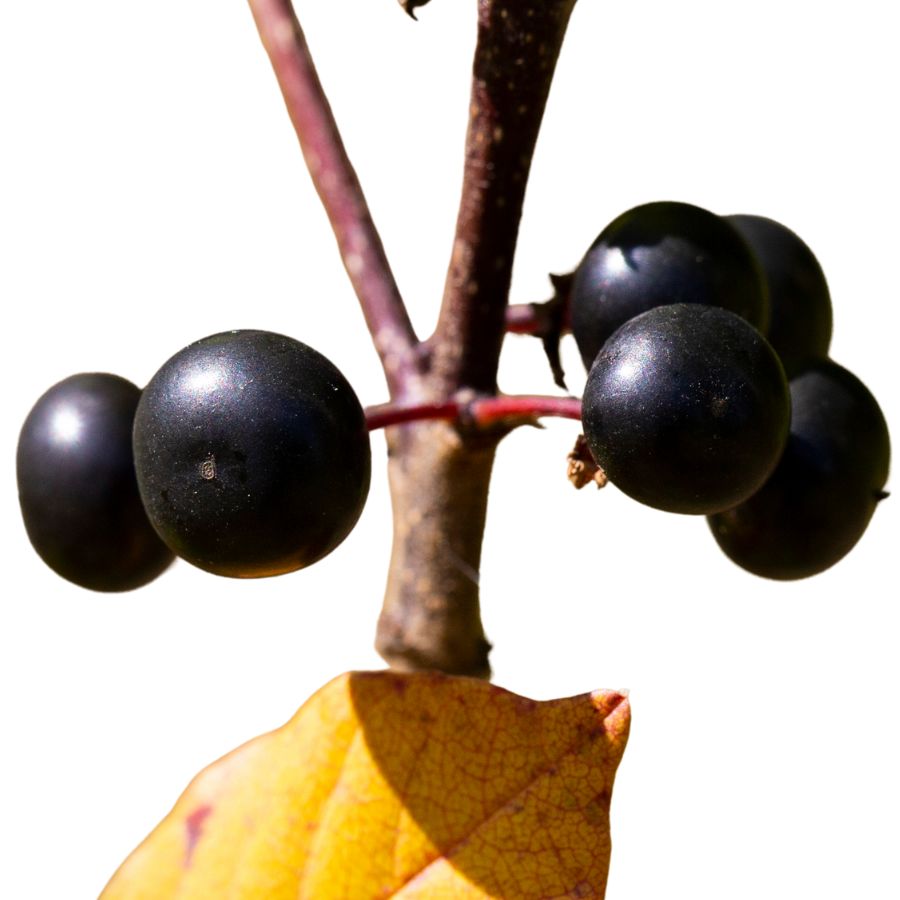
Often mistaken for: Elderberries (Sambucus spp.)
Buckthorn is a shrub or small tree often found along woodland edges, roadsides, and disturbed areas. It produces small, round berries that ripen to dark purple or black and usually grow in loose clusters.
These berries are sometimes mistaken for elderberries and other wild fruits, which also grow in dark clusters, but elderberries form flat-topped clusters on reddish stems while buckthorn berries are more scattered. Buckthorn berries are unsafe to eat as they contain compounds that can cause cramping, vomiting, and diarrhea, and large amounts may lead to dehydration and serious digestive problems.
Mayapple (Podophyllum peltatum)
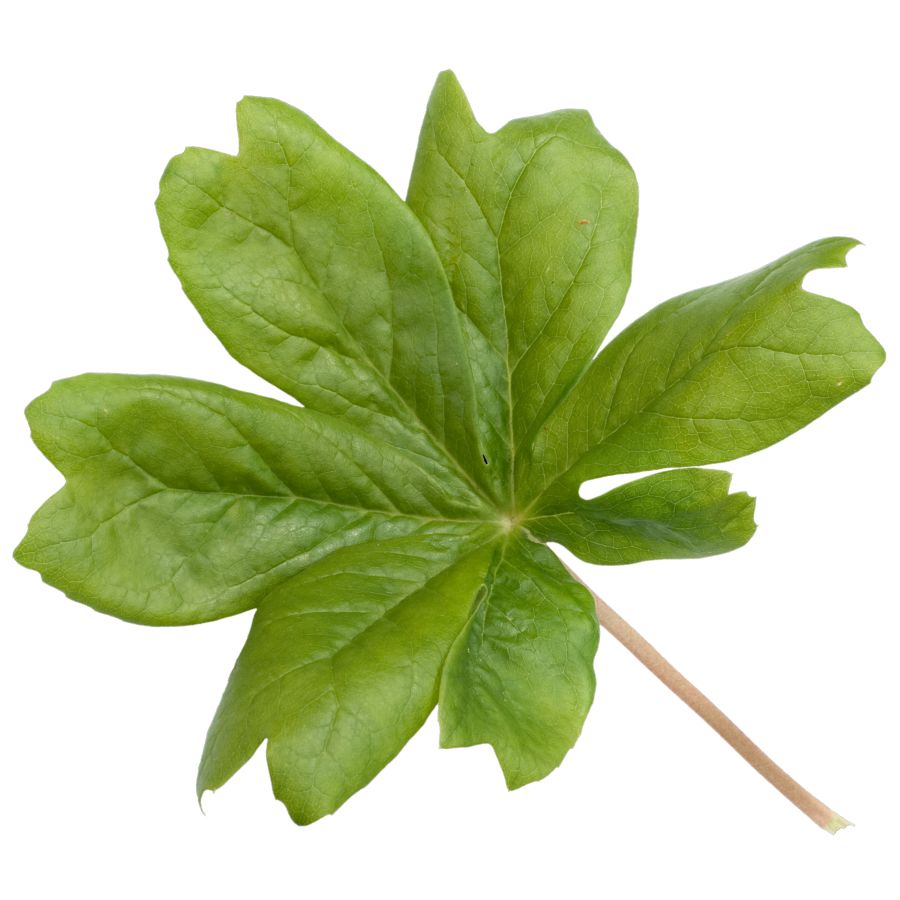
Often mistaken for: Wild grapes (Vitis spp.)
Mayapple is a low-growing plant found in shady forests and woodland clearings. It has large, umbrella-like leaves and produces a single pale fruit hidden beneath the foliage.
The unripe fruit resembles a small green grape, causing confusion with wild grapes, which grow in woody clusters on vines. All parts of the mayapple are toxic except the fully ripe, yellow fruit, which is only safe in small amounts. Eating unripe fruit or other parts can lead to nausea, vomiting, and severe dehydration.
Virginia Creeper (Parthenocissus quinquefolia)
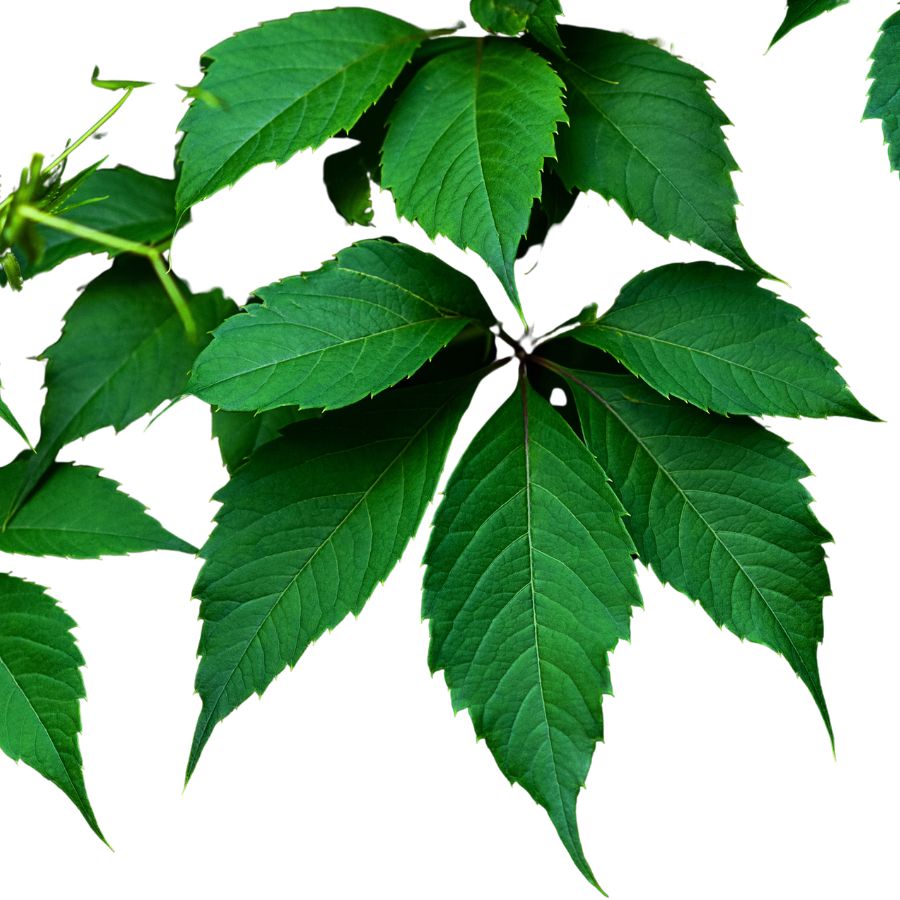
Often mistaken for: Wild grapes (Vitis spp.)
Virginia creeper is a fast-growing vine found on fences, trees, and forest edges. It has five leaflets per stem and produces small, bluish-purple berries from late summer to fall.
It’s often confused with wild grapes since both are climbing vines with similar berries, but grapevines have large, lobed single leaves and tighter fruit clusters. Virginia creeper’s berries are toxic to humans and contain oxalate crystals that can cause nausea, vomiting, and throat irritation.
Castor Bean (Ricinus communis)
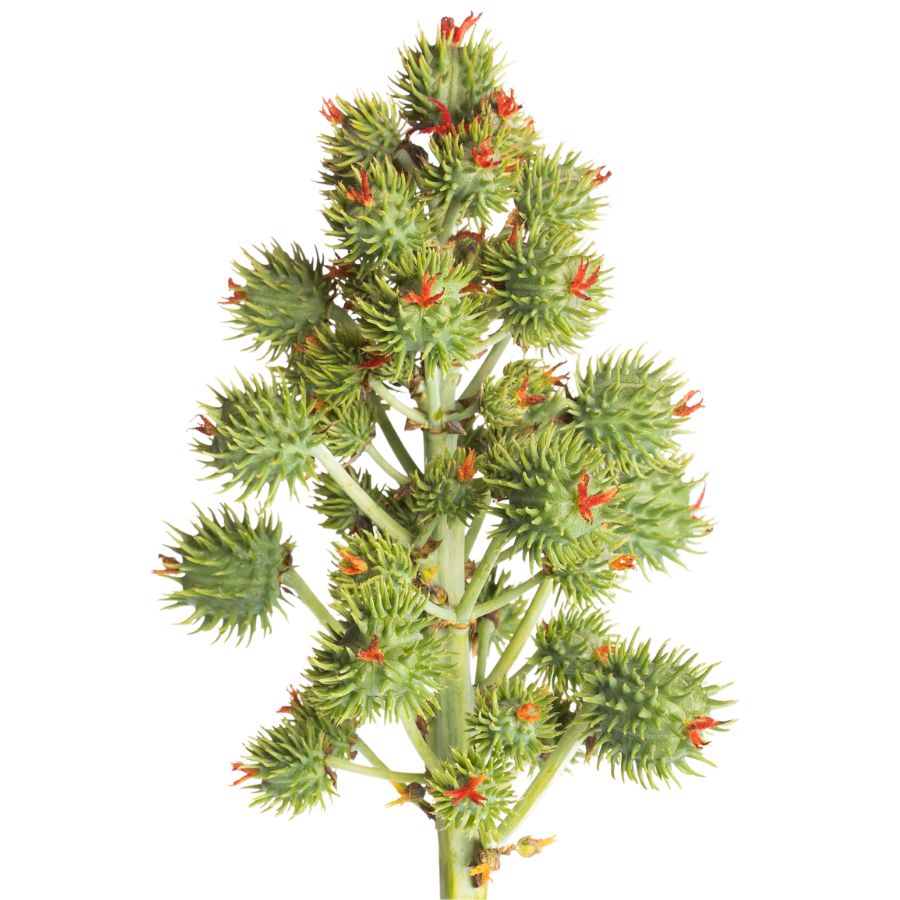
Often mistaken for: Wild rhubarb (Rumex spp. or Rheum spp.)
Castor bean is a bold plant with large, lobed leaves and tall red or green stalks, often found in gardens, along roadsides, and in disturbed areas in warmer regions in the US. Its red-tinged stems and overall size can resemble wild rhubarb to the untrained eye.
Unlike rhubarb, castor bean plants produce spiny seed pods containing glossy, mottled seeds that are extremely toxic. These seeds contain ricin, a deadly compound even in small amounts. While all parts of the plant are toxic, the seeds are especially dangerous and should never be handled or ingested.
A Quick Reminder
Before we get into the specifics about where and how to find these mushrooms, we want to be clear that before ingesting any wild mushroom, it should be identified with 100% certainty as edible by someone qualified and experienced in mushroom identification, such as a professional mycologist or an expert forager. Misidentification of mushrooms can lead to serious illness or death.
All mushrooms have the potential to cause severe adverse reactions in certain individuals, even death. If you are consuming mushrooms, it is crucial to cook them thoroughly and properly and only eat a small portion to test for personal tolerance. Some people may have allergies or sensitivities to specific mushrooms, even if they are considered safe for others.
The information provided in this article is for general informational and educational purposes only. Foraging for wild mushrooms involves inherent risks.
How to Get the Best Results Foraging
Safety should always come first when it comes to foraging. Whether you’re in a rural forest or a suburban greenbelt, knowing how to harvest wild foods properly is a key part of staying safe and respectful in the field.
Always Confirm Plant ID Before You Harvest Anything
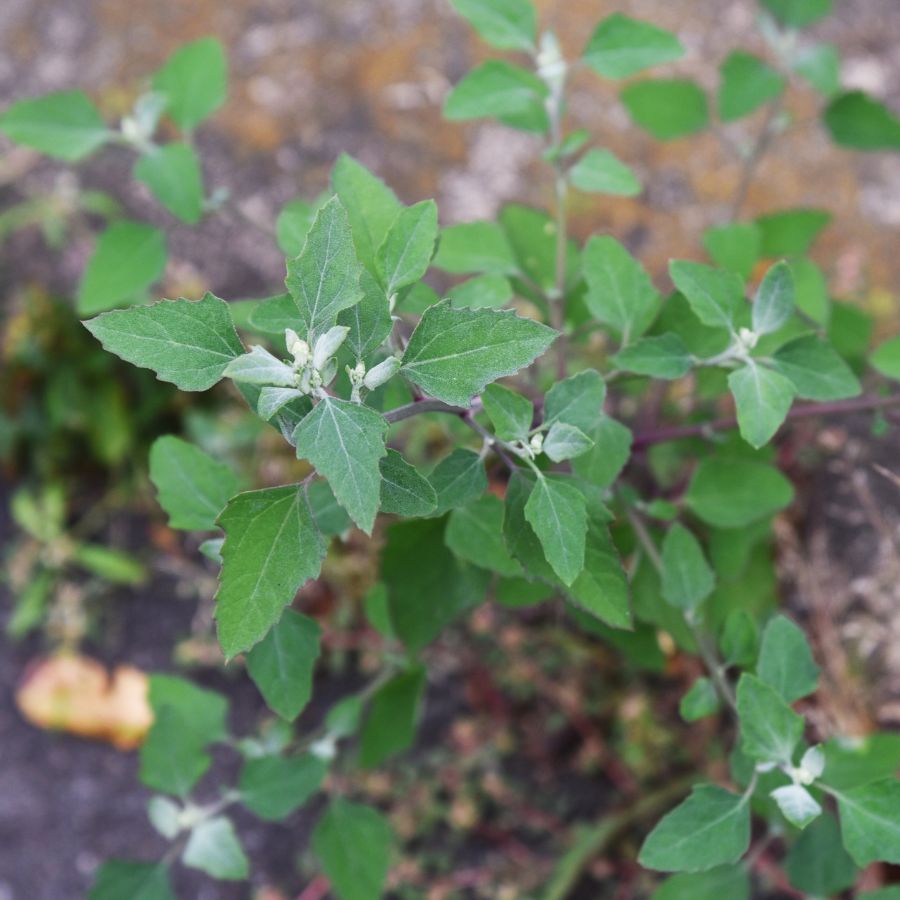
Knowing exactly what you’re picking is the most important part of safe foraging. Some edible plants have nearly identical toxic lookalikes, and a wrong guess can make you seriously sick.
Use more than one reliable source to confirm your ID, like field guides, apps, and trusted websites. Pay close attention to small details. Things like leaf shape, stem texture, and how the flowers or fruits are arranged all matter.
Not All Edible Plants Are Safe to Eat Whole
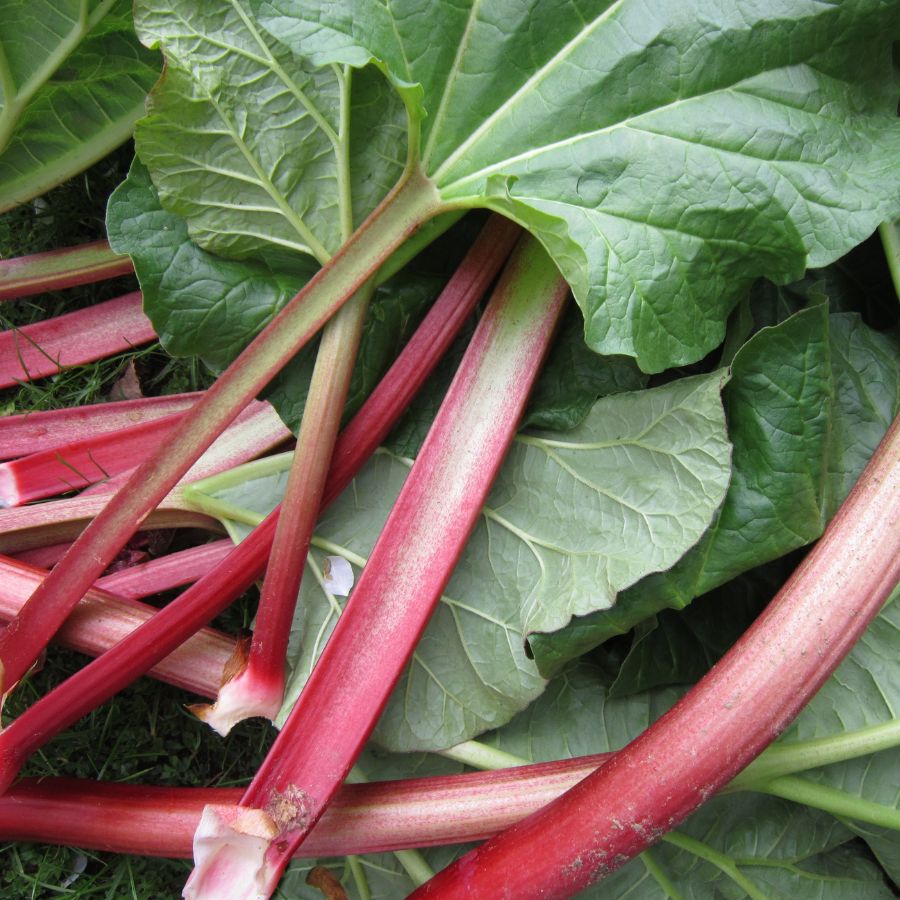
Just because a plant is edible doesn’t mean every part of it is safe. Some plants have leaves, stems, or seeds that can be toxic if eaten raw or prepared the wrong way.
For example, pokeweed is only safe when young and properly cooked, while elderberries need to be heated before eating. Rhubarb stems are fine, but the leaves are poisonous. Always look up which parts are edible and how they should be handled.
Avoid Foraging in Polluted or Contaminated Areas
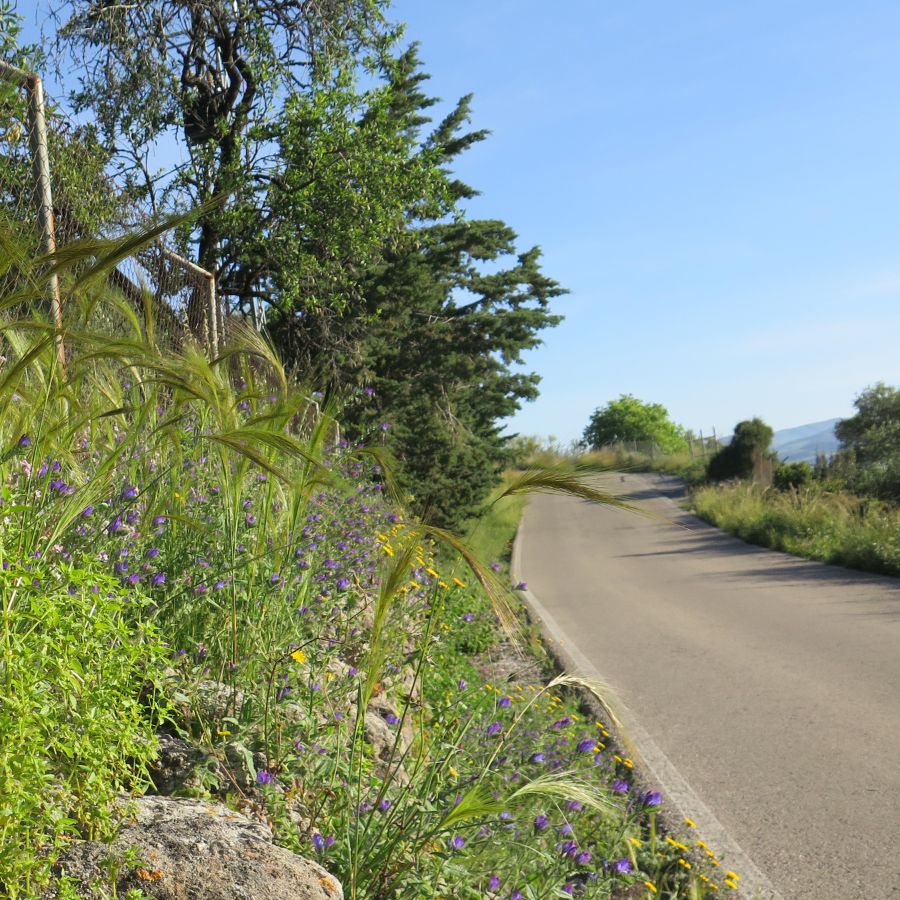
Where you forage matters just as much as what you pick. Plants growing near roads, buildings, or farmland might be coated in chemicals or growing in polluted soil.
Even safe plants can take in harmful substances from the air, water, or ground. Stick to clean, natural areas like forests, local parks that allow foraging, or your own yard when possible.
Don’t Harvest More Than What You Need
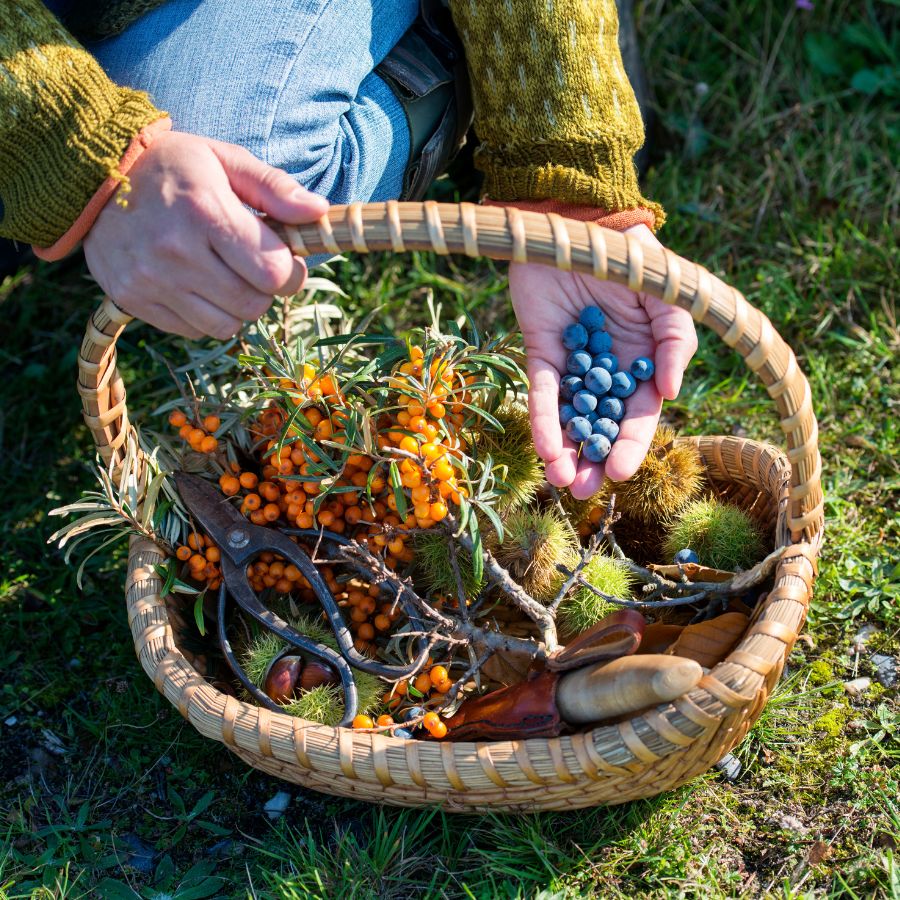
When you forage, take only what you plan to use. Overharvesting can hurt local plant populations and reduce future growth in that area.
Leaving plenty behind helps plants reproduce and supports wildlife that depends on them. It also ensures other foragers have a chance to enjoy the same resources.
Protect Yourself and Your Finds with Proper Foraging Gear

Having the right tools makes foraging easier and safer. Gloves protect your hands from irritants like stinging nettle, and a good knife or scissors lets you harvest cleanly without damaging the plant.
Use a basket or breathable bag to carry what you collect. Plastic bags hold too much moisture and can cause your greens to spoil before you get home.
This forager’s toolkit covers the essentials for any level of experience.
Watch for Allergic Reactions When Trying New Wild Foods

Even if a wild plant is safe to eat, your body might react to it in unexpected ways. It’s best to try a small amount first and wait to see how you feel.
Be extra careful with kids or anyone who has allergies. A plant that’s harmless for one person could cause a reaction in someone else.
Check Local Rules Before Foraging on Any Land
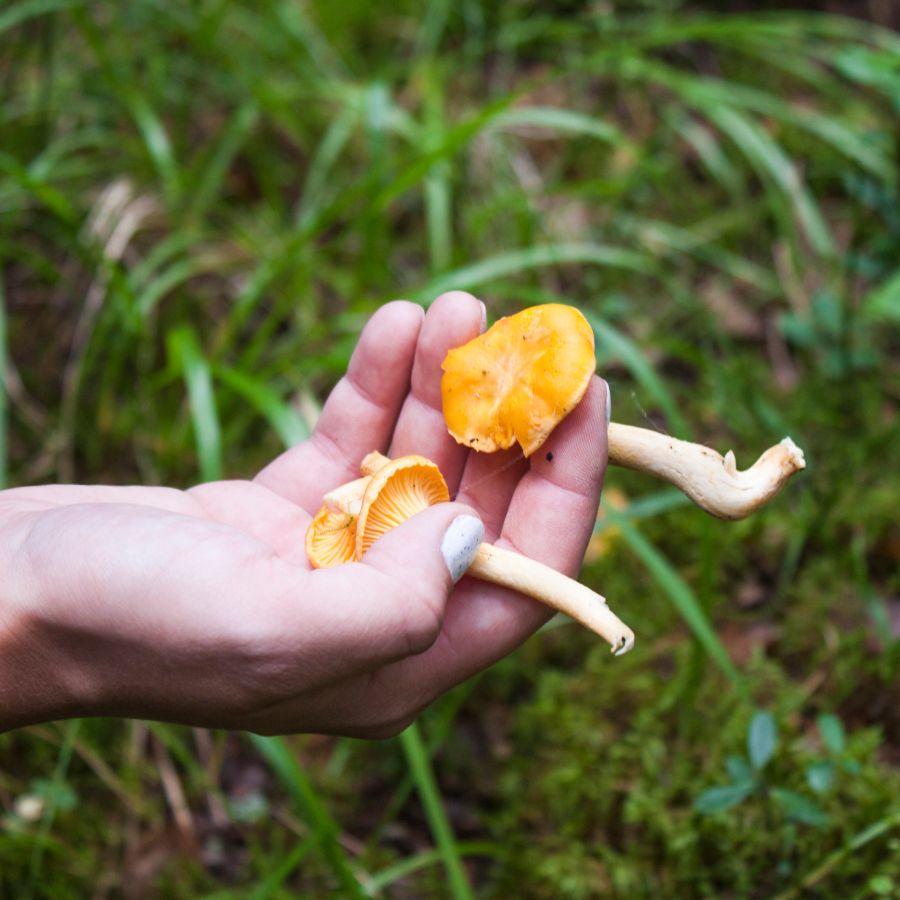
Before you start foraging, make sure you know the rules for the area you’re in. What’s allowed in one spot might be completely off-limits just a few miles away.
Some public lands permit limited foraging, while others, like national parks, usually don’t allow it at all. If you’re on private property, always get permission first.
Before you head out
Before embarking on any foraging activities, it is essential to understand and follow local laws and guidelines. Always confirm that you have permission to access any land and obtain permission from landowners if you are foraging on private property. Trespassing or foraging without permission is illegal and disrespectful.
For public lands, familiarize yourself with the foraging regulations, as some areas may restrict or prohibit the collection of mushrooms or other wild foods. These regulations and laws are frequently changing so always verify them before heading out to hunt. What we have listed below may be out of date and inaccurate as a result.
Where to Find Forageables in the State
There is a range of foraging spots where edible plants grow naturally and often in abundance:
| Plant | Locations |
| Amaranth (Amaranthus spp.) | – Rio Grande Nature Center State Park – Gila National Forest – Bosque del Apache National Wildlife Refuge |
| Wild Bergamot (Monarda fistulosa) | – Cibola National Forest – Hyde Memorial State Park – Santa Fe National Forest |
| Cattail (Typha latifolia) | – Valle de Oro National Wildlife Refuge – Bitter Lake National Wildlife Refuge – Mesilla Valley Bosque State Park |
| Cholla Cactus (Cylindropuntia spp.) | – Sevilleta National Wildlife Refuge – El Malpais National Monument – Petroglyph National Monument |
| Dandelion (Taraxacum officinale) | – Carson National Forest – Albuquerque Open Space (e.g., Elena Gallegos) – Sandia Mountains |
| Curly Dock (Rumex crispus) | – Pecos National Historical Park – Cimarron Canyon State Park – Bluewater Lake State Park |
| Fireweed (Chamerion angustifolium) | – Wheeler Peak Wilderness – Taos Ski Valley Trails – White Mountain Wilderness |
| Canyon Grape (Vitis arizonica) | – Organ Mountains–Desert Peaks National Monument – Manzano Mountains Wilderness – Gila River Corridor |
| Indian Ricegrass (Achnatherum hymenoides) | – Bisti/De-Na-Zin Wilderness – San Andres National Wildlife Refuge – Otero Mesa |
| Lamb’s Quarters (Chenopodium album) | – Fort Union National Monument – Santa Rosa Lake State Park – Farmington Lake Trails |
| Mesquite (Prosopis glandulosa) | – Chihuahuan Desert Nature Park – Bottomless Lakes State Park – McGregor Range (public access areas) |
| Narrowleaf Yucca (Yucca angustissima) | – Prehistoric Trackways National Monument – Sabinoso Wilderness – Tres Piedras Ranger District |
| Netleaf Hackberry (Celtis reticulata) | – Clayton Lake State Park – Ute Lake State Park – Red Rock Wildlife Management Area |
| Plantain (Plantago major) | – Rio Bonito Petroglyph Trail – Capulin Volcano National Monument – Eagle Nest Lake State Park |
| Tulip Prickly Pear Cactus (Opuntia phaeacantha) | – City of Rocks State Park – Jornada Experimental Range (public zones) – Taiban Mesa |
| Purslane (Portulaca oleracea) | – Albuquerque BioPark Botanic Garden paths – Roswell Spring River Trail – Truth or Consequences wetland edges |
| Rocky Mountain Bee Plant (Cleome serrulata) | – Valles Caldera National Preserve – Kasha-Katuwe Tent Rocks National Monument – Gallinas Canyon |
| Saltbush (Atriplex canescens) | – Valley of Fires Recreation Area – White Sands Missile Range buffer zones (accessible edges) – Laguna del Perro |
| Shepherd’s Purse (Capsella bursa-pastoris) | – Bandelier National Monument – Rio Grande bosque near Corrales – Los Alamos Canyon Trail |
| Skunkbush Sumac (Rhus trilobata) | – Cerrillos Hills State Park – Ojo Caliente trails – Datil Well Recreation Area |
| Sow Thistle (Sonchus oleraceus) | – Mesilla Valley Bosque State Park – Rattlesnake Springs (Carlsbad Caverns NP buffer) – Gila River Riparian Area |
| Sunflower (Helianthus annuus) | – Valle Vidal Unit, Carson National Forest – Chama River Canyon Wilderness – Las Vegas National Wildlife Refuge |
| Nodding Onion (Allium cernuum) | – Sandia Crest Trail System – Santa Fe National Forest near Aspen Vista – Pecos Wilderness near Panchuela Campground |
| Woods’ Rose (Rosa woodsii) | – Rio Costilla Park – Water Canyon (Magdalena Mountains) – San Pedro Parks Wilderness |
| Wild Rye (Elymus spp.) | – El Malpais National Conservation Area – Apache Kid Wilderness – Clayton Lake State Park |
| Wolfberry (Lycium pallidum) | – Organ Mountains–Desert Peaks National Monument – Quebradas Backcountry Byway – City of Rocks State Park |
| Wood Sorrel (Oxalis stricta) | – Hyde Memorial State Park – Gavilan Trail (Taos Ski Valley) – Bosque School Trail Area (Albuquerque) |
| Desert Hackberry (Celtis ehrenbergiana) | – White Sands Missile Range buffer zones (public access edges) – Doña Ana Mountains – San Andres National Wildlife Refuge boundary |
| New Mexico Groundcherry (Physalis hederifolia) | – Cibola National Forest near Mountainair – Zuni Mountains – Tres Piedras BLM Area |
| American Licorice (Glycyrrhiza lepidota) | – Rio Grande Valley State Park (Corrales Bosque) – Bluewater Creek Corridor – Roswell Bottomlands |
| Nuttall’s Saltbush (Atriplex nuttallii) | – Plains of San Agustin – Laguna del Perro – BLM lands near Estancia Basin |
| Western Gooseberry (Ribes inerme) | – Jemez Mountains near Battleship Rock – Gila Wilderness along Little Creek – Columbine-Hondo Wilderness |
| Prairie Onion (Allium textile) | – Fort Stanton–Snowy River Cave NCA – Otero Mesa grasslands – McGregor Range (public access side) |
| Desert Onion (Allium macropetalum) | – Chihuahuan Desert Nature Park – Big Burro Mountains – Robledo Mountains |
| Little Walnut (Juglans microcarpa) | – Little Walnut Picnic Area (near Silver City) – Guadalupe Canyon – Animas Mountains foothills |
| Colorado Pinyon (Pinus edulis) | – Gallinas Mountains – Datil Mountains – El Rito Ranger District |
| Golden Currant (Ribes aureum) | – Cimarron Canyon State Park – Rio Pueblo Valley – Gila National Forest near Sapillo Creek |
Peak Foraging Seasons
Different edible plants grow at different times of year, depending on the season and weather. Timing your search makes all the difference.
Spring
Spring brings a fresh wave of wild edible plants as the ground thaws and new growth begins:
| Plant | Months | Best Weather Conditions |
| Shepherd’s Purse (Capsella bursa-pastoris) | February – April | Mild temperatures and moist conditions |
| Dandelion (Taraxacum officinale) | March – May | Cool, moist soil after light rain or dew |
| Curly Dock (Rumex crispus) | March – May | Damp soil with moderate spring temperatures |
| Plantain (Plantago major) | March – May | Cool mornings with moist, disturbed soil |
| Sow Thistle (Sonchus oleraceus) | March – May | Cool, moist soil with light spring rain |
| Wood Sorrel (Oxalis stricta) | March – May | Mild, cloudy or damp days with soft ground |
| Lamb’s Quarters (Chenopodium album) | April – May | Warm days after spring rain, loose soil |
| Nodding Onion (Allium cernuum) | April – May | Moist, partly shaded areas in warming temps |
| American Licorice (Glycyrrhiza lepidota) | April – May | Moist streambanks or meadows after early spring rain |
| Prairie Onion (Allium textile) | April – May | Sunny weather with well-drained sandy soil |
| Golden Currant (Ribes aureum) | April – May | Cool mornings, damp soil near streambeds |
| Wild Bergamot (Monarda fistulosa) | May | Mild, sunny weather following early spring showers |
| Fireweed (Chamerion angustifolium) | May | Cool to warm temps in moist alpine areas |
Summer
Summer is a peak season for foraging, with fruits, flowers, and greens growing in full force:
| Plant | Months | Best Weather Conditions |
| Desert Onion (Allium macropetalum) | May – July | Warm, dry upland areas with scattered rain |
| Lamb’s Quarters (Chenopodium album) | June – July | Warm, sunny weather following rain |
| Cholla Cactus (Cylindropuntia spp.) | June – July | Hot, arid conditions just after monsoon rains |
| Narrowleaf Yucca (Yucca angustissima) | June – July | Arid, warm days during flowering spike emergence |
| Amaranth (Amaranthus spp.) | June – August | Hot, dry conditions in disturbed or open soil |
| Purslane (Portulaca oleracea) | June – August | Hot, dry spells with light ground moisture |
| Mesquite (Prosopis glandulosa) | June – August | Very hot, dry weather—best after seasonal rains |
| Sunflower (Helianthus annuus) | June – August | Hot, sunny days with dry soil conditions |
| Wolfberry (Lycium pallidum) | June – August | Dry heat, full sun, rocky soils |
| Rocky Mountain Bee Plant (Cleome serrulata) | July – August | Warm, sunny days with good soil drainage |
| Canyon Grape (Vitis arizonica) | July – August | Warm temperatures with some humidity |
| Netleaf Hackberry (Celtis reticulata) | July – August | Warm days; best after consistent summer sun |
| Skunkbush Sumac (Rhus trilobata) | July – August | Hot weather; fruits ripen in dry conditions |
| New Mexico Groundcherry (Physalis hederifolia) | July – August | Warm, semi-arid weather with loose soil |
| Desert Hackberry (Celtis ehrenbergiana) | July – August | Hot, dry conditions with intermittent summer storms |
| Colorado Pinyon (Pinus edulis) | August | Warm days following summer monsoons for cone ripening |
Fall
As temperatures drop, many edible plants shift underground or produce their last harvests:
| Plant | Months | Best Weather Conditions |
| Canyon Grape (Vitis arizonica) | September | Cool nights, warm days for ripening |
| Mesquite (Prosopis glandulosa) | September | Hot summer fading into cooler fall days |
| Fireweed (Chamerion angustifolium) | September | Cool, damp mornings in high-elevation areas |
| Curly Dock (Rumex crispus) | September | Moist, disturbed soil following late rains |
| Western Gooseberry (Ribes inerme) | September | Cool fall mornings, partially shaded slopes |
| Golden Currant (Ribes aureum) | September | Dry, cool weather with low humidity for ripe fruit |
| Wolfberry (Lycium pallidum) | September | Dry fall air, especially in open desert scrub |
| Wild Rye (Elymus spp.) | September | Dry, breezy afternoons in high plains or foothills |
| Skunkbush Sumac (Rhus trilobata) | September – October | Dry, sunny days enhance fruit sweetness |
| Netleaf Hackberry (Celtis reticulata) | September – October | Mild, dry fall with low humidity |
| Saltbush (Atriplex canescens) | September – October | Dry, breezy weather helps seed exposure |
| Woods’ Rose (Rosa woodsii) | September – October | Cool, crisp days with drying seed heads |
| Colorado Pinyon (Pinus edulis) | September – October | Warm, dry days after summer rain with open cones |
| Nuttall’s Saltbush (Atriplex nuttallii) | September – October | Breezy, dry plains after seasonal drought |
| Little Walnut (Juglans microcarpa) | September – October | Cool, dry days with maturing nuts along creekbeds |
Winter
Winter foraging is limited but still possible, with hardy plants and preserved growth holding on through the cold:
| Plant | Months | Best Weather Conditions |
| Cholla Cactus (Cylindropuntia spp.) | December – January | Cold nights, sunny days—spines brittle for harvesting |
| Indian Ricegrass (Achnatherum hymenoides) | December – February | Cold, dry conditions—seeds persist through snow |
| Shepherd’s Purse (Capsella bursa-pastoris) | December – February | Milder winter days with thawed soil patches |
| Saltbush (Atriplex canescens) | December – February | Dry, cold desert air; persistent seed access |
| Nuttall’s Saltbush (Atriplex nuttallii) | December – February | Cold, dry desert days with persistent seed heads |
| Desert Hackberry (Celtis ehrenbergiana) | December – February | Sunny winter days in low desert terrain |
| Tulip Prickly Pear Cactus (Opuntia phaeacantha) | January – February | Cold but sunny days; pads remain harvestable |
| Wood Sorrel (Oxalis stricta) | January – February | Milder winter days with some ground moisture |
| Sow Thistle (Sonchus oleraceus) | February | Cool weather after midwinter thaw events |
One Final Disclaimer
The information provided in this article is for general informational and educational purposes only. Foraging for wild plants and mushrooms involves inherent risks. Some wild plants and mushrooms are toxic and can be easily mistaken for edible varieties.
Before ingesting anything, it should be identified with 100% certainty as edible by someone qualified and experienced in mushroom and plant identification, such as a professional mycologist or an expert forager. Misidentification can lead to serious illness or death.
All mushrooms and plants have the potential to cause severe adverse reactions in certain individuals, even death. If you are consuming foraged items, it is crucial to cook them thoroughly and properly and only eat a small portion to test for personal tolerance. Some people may have allergies or sensitivities to specific mushrooms and plants, even if they are considered safe for others.
Foraged items should always be fully cooked with proper instructions to ensure they are safe to eat. Many wild mushrooms and plants contain toxins and compounds that can be harmful if ingested.

